Attached files
| file | filename |
|---|---|
| EX-32.2 - EXHIBIT 32.2 - UCP, Inc. | ex322_06x30x17-pirrello.htm |
| EX-32.1 - EXHIBIT 32.1 - UCP, Inc. | ex321_06x30x17-bogue.htm |
| EX-31.2 - EXHIBIT 31.2 - UCP, Inc. | ex312_06x30x17-pirrello.htm |
| EX-31.1 - EXHIBIT 31.1 - UCP, Inc. | ex311_06x30x17-bogue.htm |
UNITED STATES SECURITIES AND EXCHANGE COMMISSION
Washington, D.C. 20549
______________________
FORM 10-Q
☒ QUARTERLY REPORT PURSUANT TO SECTION 13 OR 15(d) OF THE SECURITIES EXCHANGE ACT OF 1934
For the quarterly period ended June 30, 2017
OR
☐ TRANSITION REPORT PURSUANT TO SECTION 13 OR 15(d) OF THE SECURITIES EXCHANGE ACT OF 1934
For the transition period from _____ to _____
Commission file number 001-36001

UCP, Inc.
(Exact name of registrant as specified in its charter)
Delaware (State or other jurisdiction of incorporation) | 90-0978085 (IRS Employer Identification No.) |
99 Almaden Blvd., Suite 400, San Jose, CA 95113
(Address of principal executive offices, including Zip Code)
(408) 207-9499
(Registrant’s telephone number, including area code)
Indicate by check mark whether the registrant: (1) has filed all reports required to be filed by Section 13 or 15(d) of the Securities Exchange Act of 1934 during the preceding 12 months (or for such shorter period that the registrant was required to file such reports), and (2) has been subject to such filing requirements for the past 90 days. Yes ☒ No ☐
Indicate by check mark whether the registrant has submitted electronically and posted on its corporate web site, if any, every Interactive Data File required to be submitted and posted pursuant to Rule 405 of Regulation S-T (§ 232.405 of this chapter) during the preceding 12 months (or for such shorter period that the registrant was required to submit and post such files). Yes ☒ No ☐
Indicate by check mark whether the registrant is a large accelerated filer, an accelerated filer, a non-accelerated filer, or a smaller reporting company. See definitions of “large accelerated filer,” “accelerated filer,” “smaller reporting company” and “emerging growth company” in Rule 12b-2 of the Exchange Act.
Large accelerated filer | ☐ | Accelerated filer | ☒ | ||
Non-accelerated filer | ☐ | Smaller reporting company | ☐ | ||
(Do not check if a smaller reporting company) | Emerging growth company | ☒ | |||
If an emerging growth company, indicate by check mark if the registrant has elected not to use the extended transition period for complying with any new or revised financial accounting standards provided pursuant to Section 13(a) of the Exchange Act.
Yes ☒ No ☐
Indicate by check mark whether the registrant is a shell company (as defined in Rule 12b-2 of the Exchange Act). Yes ☐ No ☒
On August 2, 2017, the registrant had 7,966,314 shares of Class A common stock, par value $0.01 per share outstanding and 100 shares of Class B common stock, par value $0.01 per share outstanding.
UCP, INC.
FORM 10-Q
TABLE OF CONTENTS
Page No. | ||
PART I - FINANCIAL INFORMATION | ||
PART II - OTHER INFORMATION | ||
2
UCP, INC.
CONDENSED CONSOLIDATED BALANCE SHEETS
(Unaudited)
(In thousands, except shares and per share data)
June 30, 2017 | December 31, 2016 | ||||||
Assets | |||||||
Cash and cash equivalents | $ | 30,510 | $ | 40,931 | |||
Restricted cash | 1,547 | 1,547 | |||||
Total cash, cash equivalents and restricted cash | 32,057 | 42,478 | |||||
Real estate inventories | 392,347 | 373,207 | |||||
Fixed assets, net | 745 | 883 | |||||
Intangible assets, net | 74 | 101 | |||||
Receivables | 6,962 | 5,628 | |||||
Deferred tax assets, net | 5,419 | 5,482 | |||||
Other assets | 6,506 | 6,327 | |||||
Total assets | $ | 444,110 | $ | 434,106 | |||
Liabilities and equity | |||||||
Accounts payable | $ | 12,293 | $ | 18,435 | |||
Accrued liabilities | 34,015 | 25,342 | |||||
Customer deposits | 4,485 | 2,449 | |||||
Notes payable, net | 84,801 | 86,658 | |||||
Senior notes, net | 74,764 | 74,336 | |||||
Total liabilities | 210,358 | 207,220 | |||||
Commitments and contingencies (Note 11) | |||||||
Equity | |||||||
Preferred stock, par value $0.01 per share, 50,000,000 authorized, no shares issued and outstanding as of June 30, 2017; no shares issued and outstanding as of December 31, 2016 | — | — | |||||
Class A common stock, $0.01 par value; 500,000,000 authorized, 8,112,660 issued and 7,966,314 outstanding as of June 30, 2017; 8,042,834 issued and 7,896,488 outstanding as of December 31, 2016 | 81 | 80 | |||||
Class B common stock, $0.01 par value; 1,000,000 authorized, 100 issued and outstanding as of June 30, 2017; 100 issued and outstanding as of December 31, 2016 | — | — | |||||
Additional paid-in capital | 97,697 | 97,123 | |||||
Treasury stock at cost; 146,346 shares as of June 30, 2017; 146,346 as of December 31, 2016 | (1,250 | ) | (1,250 | ) | |||
Accumulated earnings | 7,445 | 4,675 | |||||
Total UCP, Inc. stockholders’ equity | 103,973 | 100,628 | |||||
Noncontrolling interest | 129,779 | 126,258 | |||||
Total equity | 233,752 | 226,886 | |||||
Total liabilities and equity | $ | 444,110 | $ | 434,106 | |||
See accompanying notes to condensed consolidated financial statements.
3
UCP, INC.
CONDENSED CONSOLIDATED STATEMENTS OF OPERATIONS AND COMPREHENSIVE INCOME OR LOSS
(Unaudited)
(In thousands, except shares and per share data)
Three Months Ended June 30, | Six Months Ended June 30, | ||||||||||||||
2017 | 2016 | 2017 | 2016 | ||||||||||||
REVENUE: | |||||||||||||||
Homebuilding | $ | 113,252 | $ | 81,415 | $ | 207,255 | $ | 149,641 | |||||||
Land development | — | 1,422 | 496 | 1,422 | |||||||||||
Total revenue: | 113,252 | 82,837 | 207,751 | 151,063 | |||||||||||
COSTS AND EXPENSES: | |||||||||||||||
Cost of sales - homebuilding | 91,337 | 66,370 | 167,991 | 122,576 | |||||||||||
Cost of sales - land development | 102 | 225 | 577 | 686 | |||||||||||
Impairment on real estate | — | 2,397 | 102 | 2,397 | |||||||||||
Total cost of sales | 91,439 | 68,992 | 168,670 | 125,659 | |||||||||||
Gross margin - homebuilding | 21,915 | 15,045 | 39,264 | 27,065 | |||||||||||
Gross margin - land development | (102 | ) | 1,197 | (81 | ) | 736 | |||||||||
Gross margin - impairment on real estate | — | (2,397 | ) | (102 | ) | (2,397 | ) | ||||||||
Total gross margin | 21,813 | 13,845 | 39,081 | 25,404 | |||||||||||
Sales and marketing | 6,219 | 4,667 | 11,368 | 8,743 | |||||||||||
General and administrative | 9,883 | 7,234 | 18,385 | 14,509 | |||||||||||
Total expenses | 16,102 | 11,901 | 29,753 | 23,252 | |||||||||||
Income from operations | 5,711 | 1,944 | 9,328 | 2,152 | |||||||||||
Other income, net | 38 | 22 | 498 | 49 | |||||||||||
Net income before income taxes | $ | 5,749 | $ | 1,966 | $ | 9,826 | $ | 2,201 | |||||||
Provision for income taxes | (869 | ) | (141 | ) | (1,491 | ) | (147 | ) | |||||||
Net income | $ | 4,880 | $ | 1,825 | $ | 8,335 | $ | 2,054 | |||||||
Net income attributable to noncontrolling interest | $ | 3,256 | $ | 1,119 | $ | 5,565 | $ | 1,252 | |||||||
Net income attributable to UCP, Inc. | 1,624 | 706 | 2,770 | 802 | |||||||||||
Other comprehensive income, net of tax | — | — | — | — | |||||||||||
Comprehensive income | $ | 4,880 | $ | 1,825 | $ | 8,335 | $ | 2,054 | |||||||
Comprehensive income attributable to noncontrolling interest | $ | 3,256 | $ | 1,119 | $ | 5,565 | $ | 1,252 | |||||||
Comprehensive income attributable to UCP, Inc. | $ | 1,624 | $ | 706 | $ | 2,770 | $ | 802 | |||||||
Earnings per share of Class A common stock: | |||||||||||||||
Basic | $ | 0.20 | $ | 0.09 | $ | 0.35 | $ | 0.10 | |||||||
Diluted | $ | 0.20 | $ | 0.09 | $ | 0.35 | $ | 0.10 | |||||||
Weighted average shares of Class A common stock: | |||||||||||||||
Basic | 7,963,413 | 8,024,790 | 7,957,103 | 8,023,269 | |||||||||||
Diluted | 8,026,877 | 8,145,128 | 8,012,333 | 8,025,481 | |||||||||||
See accompanying notes to condensed consolidated financial statements.
4
UCP, INC.
CONDENSED CONSOLIDATED STATEMENTS OF EQUITY
(Unaudited)
(In thousands, except number of shares)
UCP, Inc. Shareholders’ Equity | |||||||||||||||||||||||||||||||||
Shares of common stock outstanding | Common stock | Additional paid-in capital | Treasury stock | Accumulated deficit | Noncontrolling interest | Total equity | |||||||||||||||||||||||||||
Class A | Class B | Class A | Class B | ||||||||||||||||||||||||||||||
Balance as of December 31, 2015 | 8,014,434 | 100 | $ | 80 | $ | — | $ | 94,683 | $ | — | $ | (4,563 | ) | $ | 127,208 | $ | 217,408 | ||||||||||||||||
Class A - Issuance of common stock for RSUs, net of withholding taxes paid for vested RSUs | 12,394 | (20 | ) | (25 | ) | (45 | ) | ||||||||||||||||||||||||||
Repurchase of common stock | (21,065 | ) | (160 | ) | (160 | ) | |||||||||||||||||||||||||||
Re-allocation from stock issuances | 1,856 | (1,856 | ) | — | |||||||||||||||||||||||||||||
Stock-based compensation expense | 179 | 236 | 415 | ||||||||||||||||||||||||||||||
Distribution to noncontrolling interest | (4,830 | ) | (4,830 | ) | |||||||||||||||||||||||||||||
Net income | 802 | 1,252 | 2,054 | ||||||||||||||||||||||||||||||
Balance as of June 30, 2016 | 8,005,763 | 100 | $ | 80 | $ | — | $ | 96,698 | $ | (160 | ) | $ | (3,761 | ) | $ | 121,985 | $ | 214,842 | |||||||||||||||
Balance as of December 31, 2016 | 7,896,488 | 100 | $ | 80 | $ | — | $ | 97,123 | $ | (1,250 | ) | $ | 4,675 | $ | 126,258 | $ | 226,886 | ||||||||||||||||
Class A - Issuance of common stock for RSUs, net of withholding taxes paid for vested RSUs | 69,826 | 1 | (122 | ) | (158 | ) | (279 | ) | |||||||||||||||||||||||||
Re-allocation from stock issuances | 465 | (465 | ) | — | |||||||||||||||||||||||||||||
Stock-based compensation expense | 374 | 488 | 862 | ||||||||||||||||||||||||||||||
Excess income tax benefit from stock based awards | (143 | ) | (143 | ) | |||||||||||||||||||||||||||||
Distribution to noncontrolling interest | (1,909 | ) | (1,909 | ) | |||||||||||||||||||||||||||||
Net income | 2,770 | 5,565 | 8,335 | ||||||||||||||||||||||||||||||
Balance as of June 30, 2017 | 7,966,314 | 100 | $ | 81 | $ | — | $ | 97,697 | $ | (1,250 | ) | $ | 7,445 | $ | 129,779 | $ | 233,752 | ||||||||||||||||
See accompanying notes to condensed consolidated financial statements.
5
UCP, INC.
CONDENSED CONSOLIDATED STATEMENTS OF CASH FLOWS
(Unaudited)
Six Months Ended June 30, | |||||||
(In thousands) | 2017 | 2016 | |||||
Operating activities | |||||||
Net income | $ | 8,335 | $ | 2,054 | |||
Adjustments to reconcile net income to net cash used in operating activities: | |||||||
Stock-based compensation | 862 | 415 | |||||
Excess income tax benefit from stock based awards | (143 | ) | — | ||||
Abandonment charges | 204 | 474 | |||||
Impairment on real estate inventories | 102 | 2,397 | |||||
Depreciation and amortization | 276 | 352 | |||||
Fair value adjustment of contingent consideration | — | 8 | |||||
Deferred income taxes, net | 63 | — | |||||
Changes in operating assets and liabilities: | |||||||
Real estate inventories | (17,826 | ) | (15,719 | ) | |||
Receivables | (1,334 | ) | 500 | ||||
Other assets | (266 | ) | (212 | ) | |||
Accounts payable | (6,143 | ) | 4,788 | ||||
Accrued liabilities | 8,115 | (4,585 | ) | ||||
Customer deposits | 2,036 | 1,341 | |||||
Income taxes payable | 559 | 78 | |||||
Net cash used in operating activities | (5,160 | ) | (8,109 | ) | |||
Investing activities | |||||||
Purchases of fixed assets | (120 | ) | (59 | ) | |||
Net cash used in investing activities | (120 | ) | (59 | ) | |||
Financing activities | |||||||
Distribution to noncontrolling interest | (1,909 | ) | (4,830 | ) | |||
Proceeds from notes payable | 84,059 | 67,837 | |||||
Repayment of notes payable | (85,803 | ) | (61,505 | ) | |||
Debt issuance costs | (1,209 | ) | (129 | ) | |||
Repurchase of common stock | — | (160 | ) | ||||
Withholding taxes paid for vested RSUs | (279 | ) | (46 | ) | |||
Net cash (used in) provided by financing activities | (5,141 | ) | 1,167 | ||||
Net decrease in cash, cash equivalents and restricted cash | (10,421 | ) | (7,001 | ) | |||
Cash, cash equivalents and restricted cash – beginning of period | 42,478 | 40,729 | |||||
Cash, cash equivalents and restricted cash – end of period | $ | 32,057 | $ | 33,728 | |||
Non-cash investing and financing activity | |||||||
Exercise of land purchase options acquired with acquisition of business | $ | 10 | $ | 34 | |||
Issuance of Class A common stock for vested restricted stock units | $ | 1,099 | $ | 123 | |||
Supplemental cash flow information | |||||||
Income taxes paid | $ | 1,012 | $ | 69 | |||
See accompanying notes to condensed consolidated financial statements.
6
UCP, INC.
NOTES TO CONDENSED CONSOLIDATED FINANCIAL STATEMENTS
(Unaudited)
1. ORGANIZATION, BASIS OF PRESENTATION AND SUMMARY OF SIGNIFICANT ACCOUNTING POLICIES
As used in this report, unless the context otherwise requires or indicates, references to “the Company,” “we,” “our” and “UCP” refer to UCP, Inc. and its consolidated subsidiaries, including UCP, LLC.
Business Description and Organizational Structure of the Company
The Company is a homebuilder and land developer with expertise in residential land acquisition, development and entitlement, as well as home design, construction and sales. The Company’s homebuilding and land development operations are each segmented into two geographic regions, West and Southeast. We operate in the states of California, Washington, North Carolina, South Carolina and Tennessee.
The Company’s operations began in 2004 and principally focused on acquiring land, entitling and developing it for residential construction, and selling residential lots to third-party homebuilders. In 2010, the Company formed Benchmark Communities, LLC, its wholly-owned homebuilding subsidiary, to design, construct and sell high quality single-family homes. On April 10, 2017, the Company entered into an Agreement and Plan of Merger (the “Merger Agreement”) pursuant to which the Company has agreed to merge with a wholly-owned subsidiary of Century Communities, Inc. (together with its subsidiaries and unless the context otherwise requires, “Century”). In the merger, each outstanding share of the Company’s Class A common stock, par value $0.01 per share (“Class A common stock”), will be converted into the right to receive $5.32 in cash and 0.2309 of a newly issued share of Century common stock, par value $0.01 per share (“Century Common Stock”). The transaction is expected to close during the third quarter of 2017, subject to customary closing conditions, including the adoption of the Merger Agreement by the Company’s stockholders at a special meeting. See Note 13, “Pending Merger with Century” to the accompanying unaudited condensed consolidated financial statements for a further discussion of the merger.
The Company is a holding company, whose principal asset is its interest in UCP, LLC, the subsidiary through which it directly and indirectly conducts its business. As of June 30, 2017, the Company held a 43.4% economic interest in UCP, LLC and PICO Holdings, Inc. (“PICO”), a NASDAQ-listed, diversified holding company, held the remaining 56.6% economic interest in UCP, LLC.
Basis of Presentation
The accompanying unaudited condensed consolidated financial statements include the accounts of the Company and its subsidiaries. All intercompany accounts have been eliminated in consolidation.
The accompanying unaudited condensed consolidated financial statements have been prepared in accordance with the accounting principles generally accepted in the United States of America (“GAAP”) for interim financial information and the instructions to Form 10-Q and Article 10 of Regulation S-X. These financial statements should be read in conjunction with the Company's audited financial statements for the year ended December 31, 2016, which are included in the Company’s Annual Report on Form 10-K that was filed with the Securities and Exchange Commission (“SEC”) on March 3, 2017. The accompanying unaudited condensed consolidated financial statements include all adjustments (consisting of normal recurring adjustments) necessary for the fair presentation of the Company’s results for the interim periods presented. These consolidated and segment results are not necessarily indicative of the Company’s future performance.
As an “emerging growth company,” as defined in the Jumpstart Our Business Startups Act of 2012, the Company has taken advantage of certain temporary exemptions from various reporting requirements, including reduced disclosure obligations regarding executive compensation in its periodic reports and proxy statements. The Company could be an emerging growth company until the last day of the fiscal year following the fifth anniversary of the July 23, 2013 completion of its initial public offering, although a variety of circumstances can cause it to lose this status earlier.
Use of Estimates in Preparation of Financial Statements
The preparation of condensed consolidated financial statements in accordance with GAAP requires management to make estimates and assumptions that affect the disclosure and reported amounts of assets and liabilities reported at the date of the financial statements
7
and the reported amounts of revenues and expenses for each reporting period. The significant estimates made in the preparation of the Company’s accompanying unaudited condensed consolidated financial statements relate to the assessment of real estate impairments, valuation of assets and liabilities acquired, cost capitalization, accrued obligations, warranty reserves, income taxes and contingent liabilities. While management believes that the carrying value of such assets and liabilities are appropriate as of June 30, 2017 and December 31, 2016, it is reasonably possible that actual results could differ from the estimates upon which the carrying values were based.
Related Party Transactions
Agreements Related to our Initial Public Offering
As of June 30, 2017, PICO holds an economic and voting interest in our Company equal to approximately 56.6%. The Company is party to certain agreements with PICO, including an Exchange Agreement (pursuant to which PICO has the right to cause the Company to exchange PICO’s interests in UCP, LLC for shares of the Company’s Class A common stock on a one-for-one basis, subject to equitable adjustments for stock splits, stock dividends, reclassifications and repurchases by UCP of Class A common stock), an Investor Rights Agreement (pursuant to which PICO has certain rights, including the right to select two individuals for nomination for election to the Company’s board of directors (the “Board”) for as long as PICO owns at least a 25% voting interest in the Company), a Tax Receivable Agreement (pursuant to which PICO is entitled to 85% of any cash savings in U.S. federal, state and local income tax that the Company actually realizes as a result of any increase in tax basis caused by PICO’s exchange of UCP, LLC interests for shares of the Company’s Class A common stock) and a Registration Rights Agreement, with respect to the shares of Class A common stock that PICO may receive in exchanges made pursuant to the Exchange Agreement. In connection with the pending merger transaction with Century, each of the Company, UCP, LLC and PICO has agreed to terminate the Exchange Agreement, the Tax Receivable Agreement and the Registration Rights Agreement (without any payments from, or any cost or expense to, any such party) subject to and contingent upon the completion of the proposed merger with Century.
Voting Agreement
Concurrently with the execution and delivery of the Merger Agreement, on April 10, 2017, Century, a wholly-owned subsidiary of Century, PICO, the Company and UCP, LLC entered into a voting support and transfer restriction agreement (the “Voting Agreement”). Pursuant to the terms of the Voting Agreement, PICO agreed, among other things, to vote all outstanding shares of Class A common stock and Class B common stock, par value $0.01 per share, of the Company currently held or thereafter acquired by PICO (the “PICO Shares”) in favor of the adoption of the Merger Agreement and against any proposal by third parties to acquire the Company, and to take certain other actions in furtherance of the transactions contemplated by the Merger Agreement, including the Exchange (as defined below), in each case subject to the limitations set forth in the Voting Agreement. Among other such limitations, PICO’s obligation to vote in favor of the adoption of the Merger Agreement will be reduced to such number of PICO Shares as is equal to 28% of the aggregate outstanding voting power of the Company if the Board changes its recommendation in respect of an Intervening Event (as defined in the Merger Agreement), and the Voting Agreement automatically terminates if the Merger Agreement is terminated (including if the Company terminates the Merger Agreement to accept a Superior Company Proposal, as defined in the Merger Agreement).
The foregoing description of the Voting Agreement is only a summary, does not purport to be complete and is qualified in its entirety by reference to the full text of the Voting Agreement, which is filed as an exhibit to our Current Report on Form 8-K filed with the SEC on April 11, 2017.
Agreement to Exchange
Concurrently with the execution and delivery of the Merger Agreement, on April 10, 2017, the Company, UCP, LLC and PICO entered into an agreement to exchange (the “Agreement to Exchange”), pursuant to which PICO exercised its right under the Exchange Agreement to effect the exchange of all of its Series A Units of UCP, LLC for shares of Class A common stock (the “Exchange”). Under the Agreement to Exchange, the Exchange will occur immediately prior to, and remain subject to the consummation immediately thereafter of, the merger. For further information, reference to the full text of the Agreement to Exchange is filed as an exhibit to our Current Report on Form 8-K filed with the SEC on April 11, 2017.
Segment Reporting
The Company has segmented its operating activities into two operating segments, West and Southeast, and two reportable segments, Homebuilding and Land development. Each reportable segment includes real estate with similar economic characteristics, including similar historical and expected long-term gross margin percentages, product types, geography, production processes and methods of distribution.
8
Cash and Cash Equivalents and Restricted Cash
Cash and cash equivalents include highly liquid instruments purchased with original maturities of three months or less. The Company has approximately $15.1 million of cash held in money market accounts on its condensed consolidated balance sheets as of June 30, 2017 and December 31, 2016.
Cash items that are restricted as to withdrawal or usage include deposits of $1.5 million as of June 30, 2017 and December 31, 2016, related to a construction loan, credit card agreements, contractor’s license and a letter of credit.
As part of the Company’s adoption of Accounting Standards Update 2016-18 (“ASU 2016-18”), Statement of Cash Flows - Restricted Cash, restricted cash is included as a component of cash, cash equivalents and restricted cash in the accompanying unaudited condensed consolidated statements of cash flows. ASU 2016-18 requires that the statement of cash flows explain the change during the period in the total of cash, cash equivalents, and amounts generally described as restricted cash or restricted cash equivalents on a retrospective basis. The adoption did not have a material impact on the Company’s unaudited condensed consolidated statements of cash flows during the six months ended June 30, 2017. For the six months ended June 30, 2016, the beginning and ending balances for cash, cash equivalents and restricted cash increased by approximately $0.9 million.
Capitalization of Interest
The Company capitalizes interest to real estate inventories during the period that real estate is undergoing development. Interest capitalized as a cost of real estate inventories is included in cost of sales-homebuilding or cost of sales-land development as related homes or real estate are delivered.
Advertising Expenses
The Company expenses advertising costs as incurred. Advertising expenses for the three months ended June 30, 2017 and 2016 was $0.6 million for both periods and $0.8 million and $1.0 million for the six months ended June 30, 2017 and 2016, respectively.
Real Estate Inventories and Cost of Sales
The Company capitalizes pre-acquisition costs, the purchase price of real estate, development costs and other allocated costs, including interest, during development and home construction. Pre-acquisition costs, including non-refundable land deposits, are expensed to cost of sales when the Company determines continuation of the related project is not probable. Applicable costs incurred after development or construction is substantially complete are charged to sales and marketing or general and administrative (“G&A”) expenses, as appropriate.
Land, development and other common costs are typically allocated to real estate inventories based on the number of homes to be constructed. Direct home construction costs are recorded using the specific identification method. Cost of sales-homebuilding includes the construction costs of each home and all applicable land acquisition, real estate development, capitalized interest and related allocated common costs. Changes to estimated total development costs subsequent to initial home closings in a community are allocated to remaining homes in the community. Cost of sales-land development includes land acquisition and development costs, capitalized interest, impairment charges, abandonment charges for projects that are no longer economically viable, and real estate taxes.
Real estate inventories are stated at cost, unless the carrying amount is determined not to be recoverable, in which case real estate inventories are written down to fair value.
All real estate inventories are classified as held until the Company commits to a plan to sell the real estate, the real estate can be sold in its present condition, the real estate is being actively marketed for sale and it is probable that the real estate will be sold within twelve months. Homes completed or under construction are included in real estate inventories in the accompanying unaudited condensed consolidated balance sheets at the lower of cost or net realizable value.
Impairment and Abandonment of Real Estate Inventories
The Company evaluates real estate inventories for impairment when conditions exist suggesting that the carrying amount of real estate inventories is not fully recoverable and may exceed its fair value. Indicators of impairment include, but are not limited to, significant decreases in local housing market values, decreases in the selling prices of comparable homes, significant decreases in gross margins and sales absorption rates, costs in excess of budget, and actual or projected cash flow losses. The Company prepares and analyzes cash flows at the lowest level for which there are identifiable cash flows that are independent of the cash flows of other groups of assets.
9
When estimating future cash flows of its real estate assets, the Company makes various assumptions, including: (i) expected sales prices and sales incentives (based on, among other things, an estimate of the number of homes available in the market, pricing and incentives, and potential sales price adjustments based on market and economic trends); (ii) expected sales pace and cancellation rates (based on local housing market conditions, competition and historical trends); (iii) costs incurred to date and expected to be incurred (including, but not limited to, land and land development costs, home construction costs, indirect construction costs, and selling and marketing costs); (iv) alternative product offerings that may be offered that could have an impact on sales pace, sales price and/or building costs; and (v) alternative uses for the property.
If events or circumstances indicate that the carrying amount of real estate inventories may be impaired, such impairment will be measured based upon the difference between the carrying amount and the fair value of such asset(s) determined using the estimated future discounted cash flows, excluding interest charges, generated from the use and ultimate disposition of such asset(s). Such losses, if any, are reported within cost of sales for the period.
We estimate the fair value of each impaired community by determining the present value of the estimated future cash flows at a discount rate commensurate with the risk of the respective community. In determining the fair value of land held for sale, management considers, among other things, prices for land in recent comparable sale transactions, market analysis studies, which include the estimated price a willing buyer would pay for the land, and recent bona fide offers received from third parties.
The Company did not record any impairment losses for the three months ended June 30, 2017. During the six months ended June 30, 2017, impairment losses of $0.1 million were recorded with respect to the Company’s real estate inventories at its Glenmoor community, located in Myrtle Beach, South Carolina (“Glenmoor”) during the first quarter of 2017. A model home in the Glenmoor project suffered damages due to a fire resulting in approximately $0.1 million of impairment losses. See Note 8, “Fair Value Disclosures--Non-Financial Instruments Carried at Fair Value--Non-Recurring Estimated Fair Value of Real Estate Inventories” to the accompanying unaudited condensed consolidated financial statements for a further discussion of the impairment of the real estate asset.
During the three and six months ended June 30, 2016, approximately $2.4 million of impairment losses were recorded with respect to the Company’s real estate inventories at its Sundance community, located in Bakersfield, California (“Sundance”). The 65 lots remaining at our Sundance project were under contract for sale and resulted in an impairment loss of $2.1 million, as the carrying value of these lots was written down to the contractual sales price less costs to sell. As of June 30, 2016, homes under construction and completed homes at the Sundance project had a carrying value that exceeded their estimated undiscounted cash flows. As a result, the carrying values of those remaining lots not currently under contract were adjusted to their estimated fair values resulting in an impairment loss of approximately $0.3 million.
Abandonment charges during the three months ended June 30, 2017 and 2016 was $0.1 million for both periods and were $0.2 million and $0.5 million during the six months ended June 30, 2017 and 2016, respectively. Abandonment charges are included in cost of sales in the accompanying unaudited condensed consolidated statements of operations and comprehensive income or loss for the period in which they were recorded. These charges were related to the Company electing not to proceed with one or more land acquisitions after the incurrence of costs during due diligence.
Intangible Assets
Intangible assets with determinable useful lives are amortized on a straight-line basis over the estimated remaining useful lives (ranging from six months to five years), added to the value of land when an intangible option is used to purchase the related land, or expensed in the period when the option is cancelled. Acquired intangible assets with contractual terms are generally amortized over their respective contractual lives. When certain events or changes in operating conditions occur, an impairment assessment is performed for the intangible assets.
Fixed Assets, Net
Fixed assets are carried at cost, net of accumulated depreciation. Depreciation is computed using the straight-line method over the estimated remaining useful lives of the assets. Computer software and hardware are depreciated over three to five years, office furniture and fixtures are depreciated over five years, vehicles are depreciated over five years and leasehold improvements are depreciated over the shorter of their useful life or lease term and range from one to five years. Maintenance and repairs are charged to expense as incurred, while significant improvements are capitalized. Depreciation expense is included in G&A expenses in the accompanying unaudited condensed consolidated statements of operations and comprehensive income or loss.
Receivables
10
The detail of receivables is set forth below (in thousands):
June 30, 2017 | December 31, 2016 | ||||||
Warranty insurance receivables | $ | 1,118 | $ | 1,118 | |||
Manufacturer rebates | 381 | 454 | |||||
Reimbursement for land development work | 5,095 | 4,016 | |||||
Other receivables | 368 | 40 | |||||
Total | $ | 6,962 | $ | 5,628 | |||
As of June 30, 2017 and December 31, 2016, the Company had no allowance for doubtful accounts recorded.
Other Assets
The detail of other assets is set forth below (in thousands):
June 30, 2017 | December 31, 2016 | ||||||
Customer deposits in escrow | $ | 4,466 | $ | 2,394 | |||
Prepaid expenses | 662 | 1,098 | |||||
Other deposits and prepaid interest | 1,377 | 1,345 | |||||
Funds held in escrow | — | 1,490 | |||||
Other assets | 1 | — | |||||
Total | $ | 6,506 | $ | 6,327 | |||
Homebuilding, Land Development Sales and Other Revenues Profit Recognition
In accordance with applicable guidance under Accounting Standards Codification (“ASC”) Topic 360 - Property, Plant, and Equipment, revenue from home sales and other real estate sales is recorded and any profit is recognized when the respective sales are closed. Sales are closed when all conditions of escrow are met, title passes to the buyer, appropriate consideration is received and collection of associated receivables, if any, is reasonably assured and the Company has no continuing involvement with the sold asset. The Company does not offer financing to any buyers. Sales price incentives are accounted for as a reduction of revenues when the sale is recorded. If the earnings process is not complete, the sale and any related profits are deferred for recognition in future periods. Any profit recorded is based on the calculation of cost of sales, which is dependent on an allocation of costs.
Stock-Based Compensation
Stock-based compensation expense is measured at the grant date based on the fair value of the award and is recognized as expense over the period during which the awards vest in accordance with applicable guidance under ASC Topic 718 - Compensation - Stock Compensation. See Note 9, “Equity--Stock-Based Compensation” to the unaudited condensed consolidated financial statements for further discussion on stock-based compensation.
As part of the Company’s adoption of Accounting Standards Update 2016-09 (“ASU 2016-09”), Compensation - Stock Compensation (Topic 718), the classification for the excess income tax benefit from stock based awards is presented as an operating activity on the accompanying unaudited condensed consolidated statements of cash flows. ASU 2016-09 provides clarification for certain share-based payment transactions and the classification of such transactions on the statement of cash flows and requires all amendments within ASU 2016-09 to be adopted in the same period. The adoption did not have a material impact on the Company’s unaudited condensed consolidated statements of cash flows during the three and six months ended June 30, 2017 and 2016.
Stock Repurchase Program
Our Board authorized the Stock Repurchase Program on June 6, 2016, to repurchase up to $5.0 million of the Company’s Class A common stock between June 7, 2016 and June 1, 2018. Treasury stock represents shares repurchased under the Stock Repurchase Program, which are reflected as a reduction in Stockholders’ Equity in accordance with ASC Topic 505-30 - Equity - Treasury Stock. The number of shares repurchased is based on the settlement date and factored into our weighted average calculation for earnings per share
11
(“EPS”). See Note 9, “Equity--Stock Repurchase Program” to the unaudited condensed consolidated financial statements for additional information regarding the Stock Repurchase Program.
Warranty Reserves
Estimated future direct warranty costs are accrued and charged to cost of sales-homebuilding in the period in which the related homebuilding revenue is recognized. Amounts accrued are based upon estimates of the amount the Company expects to pay for warranty work. The Company assesses the adequacy of its warranty reserves on a quarterly basis and adjusts the amounts recorded, if necessary, in the period in which the change in estimate occurs. Annually, or more frequently as needed, the Company engages a third-party actuary to assist in the analysis of warranty reserves based on historical data and industry trends for our communities. Warranty reserves are included in accrued liabilities in the accompanying unaudited condensed consolidated balance sheets.
Changes in warranty reserves are detailed in the table set forth below (in thousands):
Three months ended June 30, | Six months ended June 30, | ||||||||||||||
2017 | 2016 | 2017 | 2016 | ||||||||||||
Warranty reserves, beginning of period | $ | 6,126 | $ | 3,218 | $ | 5,642 | $ | 2,852 | |||||||
Warranty reserves accrued | 729 | 573 | 1,388 | 1,045 | |||||||||||
Warranty expenditures | (257 | ) | (129 | ) | (432 | ) | (235 | ) | |||||||
Warranty reserves, end of period | $ | 6,598 | $ | 3,662 | $ | 6,598 | $ | 3,662 | |||||||
Consolidation of Variable Interest Entities
The Company enters into purchase and option agreements for the purchase of real estate as part of the normal course of business. These purchase and option agreements enable the Company to acquire real estate at one or more future dates at pre-determined prices. The Company believes these acquisition structures reduce its financial risk associated with real estate acquisitions and holdings and allow the Company to better manage its cash position and return metrics.
In accordance with ASC Topic 810, "Consolidation," the Company assesses each purchase agreement to acquire real estate from an entity to determine if a variable interest entity ("VIE") may be created. Although the Company may not have legal title to the underlying land, if the Company determines that it is the primary beneficiary of the VIE, the Company would consolidate the VIE in its accompanying consolidated financial statements and reflect such assets and liabilities as “Real estate inventories not owned.” In determining if the Company is the primary beneficiary, the Company considers, among other things, whether it has the ability to control the activities of the VIE that most significantly impact its economic performance. Such activities include, but are not limited to: the ability to determine the budget or scope of the VIE; the ability to control financing decisions for the VIE; and the ability to acquire or dispose of property owned or controlled by the VIE.
Based on the current provisions of the relevant accounting guidance, the Company evaluated its purchase and option agreements for real estate in place as of June 30, 2017 and December 31, 2016. None met consolidation criteria under the accounting guidance.
Income Taxes
The Company’s provision for income tax expense includes federal and state income taxes currently payable and those deferred because of temporary differences between the income tax and financial reporting basis of the Company’s assets and liabilities. The asset and liability method of accounting for income taxes also requires the Company to reflect the effect of a tax rate change on accumulated deferred income taxes in income in the period in which the change is enacted.
The Company evaluates deferred tax assets regularly to determine if adjustments to its valuation allowance are required based on all available positive and negative evidence to consider whether it is more likely than not that any of the deferred tax assets will be realized. If it is more likely than not that some or all of the deferred income tax assets will not be realized, a valuation allowance is recorded.
During the three months ended December 31, 2016, the Company evaluated all available evidence in determining the likelihood that it will be able to realize all or some portion of its deferred tax assets prior to their expiration. Upon completing this evaluation, the Company concluded that it is more likely than not that the Company will be able to realize its deferred tax assets. As of June 30, 2017, the Company continues to conclude that it is more likely than not that the Company will be able to realize its deferred tax assets.
12
The Company recognizes any uncertain income tax positions on income tax returns at the largest amount that is more-likely-than-not to be sustained upon audit by the relevant taxing authority. An uncertain income tax position will not be recognized unless it has a greater than 50% likelihood of being sustained. The Company recognizes any interest and penalties related to uncertain tax positions in income tax expense. For each of the periods presented, the Company did not record any interest or penalties related to uncertain tax positions. See Note 12, “Income Taxes” to the unaudited condensed consolidated financial statements for a further discussion of the Company’s income taxes for the applicable period.
Price Participation Interests
Certain land purchase contracts and other agreements include provisions for additional payments to the land sellers. These additional payments are contingent on certain future outcomes, such as selling homes above a certain preset price or achieving an internal rate of return above a certain preset level. These additional payments, if triggered, are accounted for as cost of sales when they become due, however, they are neither fully determinable, nor due, until the transfer of title to the buyer is complete. Accordingly, no liability is recorded until the sale is complete.
Noncontrolling Interest
The Company reports the share of the results of operations that are attributable to other owners of its consolidated subsidiaries that are less than wholly-owned as noncontrolling interest in the accompanying unaudited condensed consolidated financial statements. In the accompanying unaudited condensed consolidated statements of operations and comprehensive income or loss, the income or loss attributable to the noncontrolling interest is reported separately, and the accumulated income or loss attributable to the noncontrolling interest, along with any changes in ownership of the subsidiary, is reported as a component of total equity.
As of June 30, 2017 and December 31, 2016, the noncontrolling interest reported in the accompanying unaudited condensed consolidated financial statements includes PICO's share of 56.6% and 56.8%, respectively, of the income related to UCP, LLC. See Note 9, "Equity--Noncontrolling Interest" to the unaudited condensed consolidated financial statements for further discussion on noncontrolling interest.
13
Recently Issued Accounting Standards
There were no new accounting pronouncements as of June 30, 2017 that has had or is expected to have a material impact on the Company’s accompanying unaudited condensed consolidated financial statements. For a further discussion of recently issued accounting standards that are not yet required to be adopted by the Company, see the “Recently Issued Accounting Standards” disclosed in Company’s Annual Report on Form 10-K for the year ended December 31, 2016 that was filed with the SEC on March 3, 2017.
2. INCOME PER SHARE
Basic income per share of Class A common stock is computed by dividing net income or loss attributable to UCP, Inc. by the weighted average number of shares of Class A common stock outstanding during the period. Diluted income per share of Class A common stock is computed similarly to basic income per share except that the weighted average number of shares of Class A common stock outstanding during the period is increased to include additional shares from the assumed exercise of any Class A common stock equivalents using the treasury stock method, if dilutive. The Company’s restricted stock units (“RSUs”) and stock options (“Options”) are considered Class A common stock equivalents for this purpose. Incremental Class A common stock equivalents were included in calculating diluted income per share for the three and six months ended June 30, 2017 and 2016.
Basic and diluted net income per share of Class A common stock for the three and six months ended June 30, 2017 and 2016 have been computed as follows (in thousands, except share and per share amounts):
Three months ended June 30, | Six months ended June 30, | ||||||||||||||
2017 | 2016 | 2017 | 2016 | ||||||||||||
Numerator | |||||||||||||||
Net income attributable to UCP, Inc. | $ | 1,624 | $ | 706 | $ | 2,770 | $ | 802 | |||||||
Denominator | |||||||||||||||
Weighted average number of shares of Class A common stock outstanding - basic | 7,963,413 | 8,024,790 | 7,957,103 | 8,023,269 | |||||||||||
Effect of dilutive securities: | |||||||||||||||
RSUs | 63,464 | 120,338 | 55,230 | 2,212 | |||||||||||
Total shares for purpose of calculating diluted net income per share | 8,026,877 | 8,145,128 | 8,012,333 | 8,025,481 | |||||||||||
Earnings per share: | |||||||||||||||
Net income per share of Class A common stock - basic | $ | 0.20 | $ | 0.09 | $ | 0.35 | $ | 0.10 | |||||||
Net income per share of Class A common stock - diluted | $ | 0.20 | $ | 0.09 | $ | 0.35 | $ | 0.10 | |||||||
The following RSUs and Options issued were excluded in the computation of diluted EPS for the three and six months ended June 30, 2017 and 2016 because the effect would be anti-dilutive:
Three months ended June 30, | Six months ended June 30, | ||||||||||
2017 | 2016 | 2017 | 2016 | ||||||||
Anti-dilutive securities | 630,303 | 267,550 | 596,765 | 282,769 | |||||||
14
3. REAL ESTATE INVENTORIES
Real estate inventories consisted of the following (in thousands):
June 30, 2017 | December 31, 2016 | ||||||
Deposits and pre-acquisition costs | $ | 10,632 | $ | 9,232 | |||
Land held and land under development | 119,140 | 101,609 | |||||
Finished lots | 54,436 | 86,622 | |||||
Homes completed or under construction | 180,134 | 148,627 | |||||
Model homes | 28,005 | 27,117 | |||||
Total | $ | 392,347 | $ | 373,207 | |||
Deposits and pre-acquisition costs include costs relating to land purchase or option contracts. Land held and land under development includes costs incurred during site development, such as land, development, indirect costs and permits. Homes completed or under construction and model homes include all costs associated with home construction, including land, development, indirect costs, permits and fees, and vertical construction.
As of June 30, 2017, the Company had $10.6 million of deposits and pre-acquisition costs for 2,173 lots with an aggregate purchase price of approximately $105.4 million, net of deposits. As of December 31, 2016, the Company had $9.2 million of deposits and pre-acquisition costs for 2,607 lots with an aggregate purchase price of approximately $106.0 million, net of deposits.
As of June 30, 2017 and December 31, 2016, the Company had completed homes included in inventories of approximately $24.4 million and $21.1 million, respectively, as shown in the charts below ($ in millions):
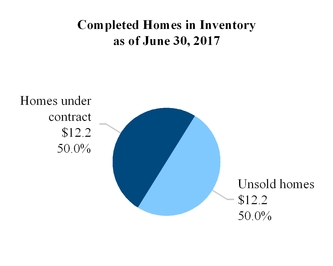
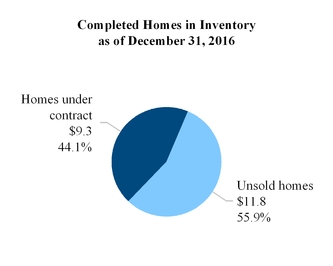
15
Interest Capitalization
Amounts capitalized to home inventories and land inventories were as follows (in thousands):
Three months ended June 30, | Six months ended June 30, | ||||||||||||||
2017 | 2016 | 2017 | 2016 | ||||||||||||
Interest expense capitalized as cost of home inventory | $ | 4,161 | $ | 2,807 | $ | 6,822 | $ | 5,175 | |||||||
Interest expense capitalized as cost of land inventory | 678 | 370 | 1,096 | 945 | |||||||||||
Total interest expense capitalized | 4,839 | 3,177 | 7,918 | 6,120 | |||||||||||
Previously capitalized interest expense included in cost of sales - homebuilding | (2,735 | ) | (1,790 | ) | (5,084 | ) | (3,329 | ) | |||||||
Previously capitalized interest expense included in cost of sales - land development | — | (146 | ) | (11 | ) | (146 | ) | ||||||||
Net activity of capitalized interest | 2,104 | 1,241 | 2,823 | 2,645 | |||||||||||
Capitalized interest expense in beginning inventory | 18,378 | 14,678 | 17,659 | 13,274 | |||||||||||
Capitalized interest expense in ending inventory | $ | 20,482 | $ | 15,919 | $ | 20,482 | $ | 15,919 | |||||||
Interest is capitalized on real estate inventories during development. Interest capitalized is included in cost of sales in the Company’s accompanying unaudited condensed consolidated statements of operations and comprehensive income or loss as related sales are recognized.
4. FIXED ASSETS, NET
Net fixed assets consisted of the following (in thousands):
June 30, 2017 | December 31, 2016 | ||||||
Computer hardware and software | $ | 2,062 | $ | 2,043 | |||
Office furniture and equipment and leasehold improvements | 935 | 911 | |||||
Vehicles | 161 | 83 | |||||
Total | 3,158 | 3,037 | |||||
Accumulated depreciation | (2,413 | ) | (2,154 | ) | |||
Fixed assets, net | $ | 745 | $ | 883 | |||
Depreciation expense for the three months ended June 30, 2017 and 2016 was $124,000 and $188,000, respectively, and $259,000 and $335,000 for the six months ended June 30, 2017 and 2016, respectively. Depreciation expense is recorded in G&A expenses in the accompanying unaudited condensed consolidated statements of operations and comprehensive income or loss.
16
5. INTANGIBLE ASSETS
Other purchased intangible assets consisted of the following:
June 30, 2017 | December 31, 2016 | ||||||||||||||||||||||
(in thousands) | Gross Carrying Amount | Accumulated Amortization | Ending Balance | Gross Carrying Amount | Accumulated Amortization | Ending Balance | |||||||||||||||||
Architectural plans | $ | 170 | $ | (111 | ) | $ | 59 | $ | 170 | $ | (94 | ) | $ | 76 | |||||||||
Land option | 583 | (568 | ) | 15 | 583 | (558 | ) | 25 | |||||||||||||||
Total | $ | 753 | $ | (679 | ) | $ | 74 | $ | 753 | $ | (652 | ) | $ | 101 | |||||||||
Amortization expense for the three months ended June 30, 2017 and 2016 related to the architectural plans was approximately $8,500 for both periods. For the six months ended June 30, 2017 and 2016, amortization expense related to the architectural plans was approximately $17,000 for both periods. The architectural plans intangible amortization period is 5 years. Amortization expense is recorded in G&A expenses in the accompanying unaudited condensed consolidated statements of operations and comprehensive income or loss. Future estimated amortization expense related to the architectural plans intangibles over the next five years is as follows:
(in thousands) | December 31, | ||
Remainder of 2017 | $ | 17 | |
2018 | 34 | ||
2019 | 8 | ||
Total | $ | 59 | |
Additionally, there were zero and $10,000 related to land options capitalized to real estate inventories for the three and six months ended June 30, 2017, respectively, as compared to $27,000 and $34,000 for the three and six months ended June 30, 2016, respectively.
For the three and six months ended June 30, 2017, no charges were related to land option abandonment for both periods, as compared to $15,000 for both periods during three and six months ended June 30, 2016.
6. ACCRUED LIABILITIES
Accrued liabilities consisted of the following (in thousands):
17
7. NOTES PAYABLE AND SENIOR NOTES, NET
The Company obtains various types of debt financing in connection with its acquisition, development and construction of real estate inventories and its construction of homes. Often, these debt obligations are secured by the underlying real estate. Certain loans are funded in full at the initial loan closing and others are revolving facilities under which the Company may borrow, repay and reborrow up to a specified amount during the term of the loan. Acquisition indebtedness matures on various dates, but is generally repaid when lots are released from the lien securing the relevant loan based upon a specific release price, as defined in the relevant loan agreement, or the loan is refinanced. Construction and development debt is required to be repaid with proceeds from home closings based upon a specific release price, as defined in the relevant loan agreement.
Certain construction and development debt agreements include provisions that require minimum tangible net worth and liquidity; limit leverage and risk asset ratios; specify maximum loan-to-cost or loan-to-value ratios (whichever is lower). During the term of the loan, the lender may require the Company to obtain a third-party written appraisal of the fair value of the underlying real estate collateral. If the appraised fair value of the collateral securing the loan is below the specified minimum, the Company may be required to make principal payments in order to maintain the required loan-to-value ratios. As of June 30, 2017 and December 31, 2016, the Company had approximately $169.8 million and $164.0 million, respectively, of loan commitments related to its acquisition, development and construction loans (“ADC”). Of the total loan commitments as of June 30, 2017 and December 31, 2016, approximately $84.6 million and $77.2 million, respectively, was available to the Company. As of June 30, 2017 and December 31, 2016, the weighted average interest rate on the Company’s outstanding debt was 6.67% and 6.48%, respectively. Interest rates charged under the Company’s variable rate debt are based on the 30-day London Interbank Offered Rate (“LIBOR”) plus a spread ranging from 2.75% to 3.75% or the U.S. Prime rate (“Prime”) plus a spread of 0.99%.
The Company’s 2017 Senior Notes (the “2017 Notes”) with $75.0 million in principal outstanding mature in October of 2017, and an additional $30.1 million in ADC loans are also set to mature in the ordinary course of business during 2017. With respect to the $30.1 million in ADC loans, these loans are project specific loans and are scheduled to mature in the ordinary course of closing out of the sales phase for each of these projects and we anticipate the sales proceeds from the designated home closings will provide a more than adequate source of cash for the repayment of these loans. For the 2017 Senior Notes our existing available cash, available borrowing capacity and cash expected to be generated from our backlog of home sales will be sufficient to repay this obligation when due.
On October 21, 2014, the Company completed the private offering of $75.0 million in aggregate principal amount of the 8.5% 2017 Notes. The net proceeds from the offering were approximately $72.5 million, after paying the debt issuance costs and offering expenses. The net proceeds from the offering were used for general corporate purposes, including financing construction of homes, acquisition of entitled land, development of lots and working capital.
The 2017 Notes were issued under an Indenture, dated as of October 21, 2014 (the “Indenture”), among the Company, certain subsidiary guarantors and Wilmington Trust, National Association, as trustee. The 2017 Notes bear interest at 8.5% per annum, payable on March 31, June 30, September 30 and December 31 of each year. The 2017 Notes mature on October 21, 2017, unless earlier redeemed or repurchased.
As of June 30, 2017, the Company was in compliance with the applicable financial covenants under the Indenture and all of its loan agreements.
18
Notes payable and 2017 Notes consisted of the following (in thousands):
Variable Interest Rate: | June 30, 2017 | December 31, 2016 | |||||
LIBOR + 3.50% through 2017 (a) | $ | 2,920 | $ | 4,693 | |||
LIBOR + 3.75% through 2017 (a) | 20,175 | 31,533 | |||||
Prime + 0.25% through 2018 (b) | 1,884 | — | |||||
LIBOR + 2.75% through 2018 (a) | 14,000 | 10,500 | |||||
LIBOR + 3.75% through 2018 (a) | 34,271 | 26,444 | |||||
5.50% through 2017 | 1,844 | 2,476 | |||||
5.00% through 2017 | 2,940 | 5,607 | |||||
Total variable notes payable | $ | 78,034 | $ | 81,253 | |||
Fixed Interest Rate: | June 30, 2017 | December 31, 2016 | |||||
8.00% through 2017 | $ | 3,000 | $ | — | |||
10.00% through 2017 | — | 1,604 | |||||
8.00% through 2018 | 4,000 | 4,000 | |||||
Total fixed notes payable | $ | 7,000 | $ | 5,604 | |||
Senior notes, net of discount | 74,951 | 74,871 | |||||
Total notes payable and senior notes | $ | 159,985 | $ | 161,728 | |||
Debt issuance costs (c) | (420 | ) | (734 | ) | |||
Total notes payable and senior notes, net | $ | 159,565 | $ | 160,994 | |||
(a) | LIBOR is the 30-day London Interbank Offered Rate. As of June 30, 2017, LIBOR was 1.22389%. |
(b) | Prime is the U.S Prime Rate. At June 30, 2017, Prime was 4.25%. |
(c) | Debt issuance costs for non-revolver loans were $0.4 million and $0.7 million as of June 30, 2017 and December 31, 2016, respectively. |
As of June 30, 2017, principal maturities of notes payable and senior notes for the years ending December 31 are as follows:
(in thousands) | December 31, | ||
2017 | $ | 105,830 | |
2018 | 54,155 | ||
2019 and thereafter | — | ||
Total | $ | 159,985 | |
19
8. FAIR VALUE DISCLOSURES
The accounting guidance regarding fair value disclosures defines fair value as the price that would be received for selling an asset or the price paid to transfer a liability in an orderly transaction between market participants at the measurement date under current market conditions.
The Company determines the fair values of its financial instruments based on the fair value hierarchy established in accordance with ASC Topic 820 - Fair Value Measurements, which requires an entity to maximize the use of observable inputs and minimize the use of unobservable inputs when measuring fair value. The classification of a financial asset or liability within the hierarchy is based upon the lowest level input that is significant to the fair value measurement. The fair value hierarchy prioritizes the inputs into three levels that may be used to measure fair value:
• | Level 1—Quoted prices for identical instruments in active markets |
• | Level 2—Quoted prices for similar instruments in active markets; quoted prices for identical or similar instruments in markets that are inactive; and model-derived valuations in which all significant inputs and significant value drivers are observable in active markets at measurement date |
• | Level 3—Valuations derived from techniques where one or more significant inputs or significant value drivers are unobservable in active markets at measurement date |
Estimated Fair Value of Financial Instruments Not Carried at Fair Value
As of June 30, 2017 and December 31, 2016, the fair values of cash and cash equivalents, accounts payable and receivable approximated their carrying values because of the short-term nature of these assets or liabilities. The estimated fair value of the Company’s debt is based on cash flow models discounted at current market interest rates for similar instruments, which are based on Level 3 inputs. There were no transfers between fair value hierarchy levels during the six months ended June 30, 2017 or the year ended December 31, 2016.
The following presents the carrying value and fair value of the Company’s financial instruments that are not carried at fair value:
June 30, 2017 | December 31, 2016 | ||||||||||||||||
(in thousands) | Level in Fair Value Hierarchy | Carrying Value | Estimated Fair Value | Carrying Value | Estimated Fair Value | ||||||||||||
Notes payable | Level 3 | $ | 85,034 | $ | 84,984 | $ | 86,857 | $ | 86,843 | ||||||||
2017 notes | Level 3 | 74,951 | 74,944 | 74,871 | 74,838 | ||||||||||||
Total debt | $ | 159,985 | $ | 159,928 | $ | 161,728 | $ | 161,681 | |||||||||
The estimated fair value of the Company's debt is the present value of the contractual debt payments, based on cash flow models, discounted at the then-current interest rates, plus an estimate of the then-current credit spread, which is an estimate of the rate at which the Company could obtain replacement debt. These parameters are Level 3 inputs in the fair value hierarchy. To estimate the contractual cash flows, discount rates, and thereby the debt fair value, the Company considers various internal and external factors including: (1) loan economic data, (2) collateral performance, (3) market interest rate data, (4) the discount curve and implied forward rate curve, and (5) other factors, which may include market, region and asset type evaluations. While the Company considered rates on existing and recently closed loan facilities in addition to the current refinancing fixed rate as of June 30, 2017, these unobservable inputs were not incorporated into its final estimate of fair value.
Recurring Financial Instruments Carried at Fair Value
The following presents the Company’s recurring financial instruments that are carried at fair value (in thousands):
Description | Level 1 | Level 2 | Level 3 | Balance at June 30, 2017 | ||||||||||
Contingent consideration | — | — | $ | 360 | $ | 360 | ||||||||
Description | Level 1 | Level 2 | Level 3 | Balance at December 31, 2016 | ||||||||||
Contingent consideration | — | — | $ | 360 | $ | 360 | ||||||||
20
Estimated Fair Value of Contingent Consideration
The change in estimated fair value of the contingent consideration relating to our 2014 acquisition of the assets and liabilities of Citizens Homes, Inc. used in the purchase of real estate and the construction and marketing of residential homes in North Carolina, South Carolina and Tennessee (the “Citizens Acquisition”) for the six months ended June 30, 2017 and 2016 consisted of the following (in thousands):
Contingent Consideration | ||||
Balance as of December 31, 2015 | $ | 2,707 | ||
Change in fair value | 8 | |||
Balance as of June 30, 2016 | $ | 2,715 | ||
Contingent Consideration | ||||
Balance as of December 31, 2016 | $ | 360 | ||
Change in fair value | — | |||
Balance as of June 30, 2017 | $ | 360 | ||
The contingent consideration arrangement relating to Citizens Acquisition requires the Company to pay up to a maximum of $6.0 million of additional consideration based upon the achievement of various pre-tax net income performance milestones ("performance milestones") by the assets acquired in the Citizens Acquisition over a five-year period that commenced on April 1, 2014. Payout calculations are made based on calendar year performance except for the sixth payout calculation which will be calculated based on the achievement of performance milestones from January 1, 2019 through March 25, 2019. Payouts are made on an annual basis. The potential undiscounted amount of all future payments that the Company could be required to make under the contingent consideration arrangement is between $0 and $6 million.
The fair value of the contingent consideration of $0.4 million as of June 30, 2017 was estimated based on applying the weighted probability of achievement of the performance milestones. There was no change in estimated fair value of the contingent consideration for the six months ended June 30, 2017. For the six months ended June 30, 2016, the change in estimated fair value of the contingent consideration was $8,000.
The fair value of the contingent consideration of $0.4 million as of June 30, 2017 was estimated based on significant inputs that are not observable in the market, which ASC Topic 820 - Fair Value Measurements, refers to as Level 3 inputs. Key assumptions include: (1) forecast adjusted pre-tax net income over the contingent consideration period; (2) revenue appreciation; (3) cost inflation; and (4) sales and marketing and general and administrative (“SG&A”) expenses. The estimated revenue appreciation of 4.5%, cost inflation of 1.5%, and SG&A expenses were applied to forecast adjusted net income over the contingent consideration period.
The fair value of the contingent consideration of $2.7 million as of June 30, 2016 was estimated based on applying the income approach and a weighted probability of achievement of the performance milestones. The estimated fair value of the contingent consideration was calculated by using a Monte Carlo simulation. The measurement is based on significant inputs that are not observable in the market, which ASC Topic 820 - Fair Value Measurements, refers to as Level 3 inputs. Key assumptions include: (1) forecast adjusted pre-tax net income over the contingent consideration period; (2) risk-adjusted discount rate reflecting the risk inherent in the forecast adjusted pre-tax net income; (3) risk-free interest rates; (4) volatility of adjusted pre-tax net income; and (5) the Company’s credit spread. The risk-adjusted discount rate applied to forecast adjusted net income was 12.7% plus the applicable risk-free rate, resulting in a discount rate ranging from 12.7% to 13.2% over the contingent consideration period. The estimated volatility rate of 18.6% and a credit spread of 11.0% were applied to forecast adjusted net income over the contingent consideration period.
Non-Financial Instruments Carried at Fair Value
Non-financial assets and liabilities include items such as inventory and long lived assets that are measured at fair value, on a nonrecurring basis, when events and circumstances indicate the carrying value is not recoverable.
Non-Recurring Estimated Fair Value of Real Estate Inventories
The following presents the Company’s non-financial instruments that were measured at fair value, on a non-recurring basis, by level within the fair value hierarchy (in thousands):
21
At June 30, 2017: | ||||||||||||
Description | Level 1 | Level 2 | Level 3 | Total Impairment During the Six Months Ended June 30, 2017 | ||||||||
Real estate and development costs - Glenmoor model home | $ | — | $ | 102 | ||||||||
At December 31, 2016: | ||||||||||||
Description | Level 1 | Level 2 | Level 3 | Total Impairment During the Year Ended December 31, 2016 | ||||||||
Real estate and development costs - Heathers at Westport project | $ | 1,066 | $ | 192 | ||||||||
Real estate and development costs - Sundance project | $ | 5,782 | $ | 2,397 | ||||||||
For the three months ended June 30, 2017, the Company had no non-recurring fair value measurement that resulted in a real estate impairment loss with respect to the Company’s real estate inventories. During the six months ended June 30, 2017, the Company had a non-recurring fair value measurement that resulted in a real estate impairment loss of $0.1 million at its Glenmoor project in South Carolina for a model home that suffered damages due to a fire. The carrying value of Glenmoor model home was written down to its fair value. See Note 1, “Organization, Basis of Presentation and Summary of Significant Accounting Policies” to the accompanying unaudited condensed consolidated financial statements for further discussion on impairment of real estate inventories.
For the three and six months ended June 30, 2016, the Company had a non-recurring fair value measurement for a land development real estate asset located in Bakersfield, California, the Sundance project. The Company entered into a contract to sell the remaining lots in the Sundance project for less than their carrying value at a future date. As a result, the Sundance project was written down to its fair value, less selling costs. As of June 30, 2016, homes under construction and completed homes in the Sundance project had a carrying value in excess of their estimated undiscounted cash flows. As a result, their carrying values were written down to their fair value. For the three and six months ended June 30, 2016, impairment losses of $2.4 million were recorded to real estate inventories at the Sundance project.
There were no other non-financial fair value measurements for the three months ended June 30, 2017 and year ended December 31, 2016.
22
9. EQUITY
Noncontrolling Interest
As of June 30, 2017 and December 31, 2016, the Company held an economic interest in UCP, LLC and is its sole managing member of approximately 43.4% and 43.2%, respectively. The noncontrolling interest reported in the accompanying unaudited condensed consolidated financial statements includes PICO’s 56.6% and 56.8% share of the income related to UCP, LLC as of June 30, 2017 and December 31, 2016, respectively.
The carrying value and ending balance as of June 30, 2017 and December 31, 2016 of the noncontrolling interest was calculated as follows (in thousands):
June 30, 2017 | December 31, 2016 | ||||||
Beginning balance of noncontrolling interest | $ | 126,258 | $ | 127,208 | |||
Net income attributable to noncontrolling interest | 5,565 | 5,210 | |||||
Re-allocation of stock issuances | (465 | ) | (1,962 | ) | |||
Stock-based compensation expense attributable to noncontrolling interest | 488 | 657 | |||||
Stock issuance attributable to noncontrolling interest | (158 | ) | (25 | ) | |||
Distribution to noncontrolling interest | (1,909 | ) | (4,830 | ) | |||
Ending balance of noncontrolling interest | $ | 129,779 | $ | 126,258 | |||
The distribution to the noncontrolling interest relates to cash distributions, which we refer to as “tax distributions,” that UCP, LLC is obligated to make as noted in the Company’s Annual Report on Form 10-K that was filed with the SEC on March 3, 2017.
Stock Repurchase Program
As part of the Board approved Stock Repurchase Program, between June 7, 2016 and June 1, 2018, management is authorized to repurchase up to $5.0 million of the Company’s Class A common stock in open market purchases, privately negotiated transactions or other transactions. The Stock Repurchase Program is subject to prevailing market conditions and other considerations, including our liquidity, the terms of our debt instruments, planned land investment and development spending, acquisition and other investment opportunities and ongoing capital requirements.
Since inception of the program through June 30, 2017, the Company repurchased an aggregate of 146,346 shares of Class A common stock for total consideration of $1.2 million, inclusive of commissions. The remaining value of shares that may be repurchased under the Stock Repurchase Program as of June 30, 2017 is approximately $3.8 million. For the three and six months ended June 30, 2017, the Company had no stock repurchases. For the three and six months ended June 30, 2016, the Company repurchased an aggregate of 21,065 shares of Class A common stock for total consideration of $160,000, inclusive of commissions.
Re-Allocation from Stock Issuances
The Company allocates Class A common stock issued in connection with the vesting of RSUs issued under the UCP, Inc. 2013 Long-Term Incentive Plan (the “LTIP”) and stock-based compensation expense between additional paid-in-capital and noncontrolling interest within its accompanying unaudited condensed consolidated statements of equity. The equity allocations for the noncontrolling interest are based on the economic and voting interest percentages of the Company and its noncontrolling interest holder, PICO. Issuances of Class A common stock for RSUs affect the economic and voting interest percentages, which accordingly are adjusted at the end of each issuance period. The economic and voting interest percentages prevailing during the period are used to determine the current period equity allocations for the noncontrolling interest.
23
Stock-Based Compensation
The LTIP was adopted in July 2013 and provides for the grant of equity-based awards, including options to purchase shares of Class A common stock, Class A stock appreciation rights, Class A restricted stock, Class A RSUs and performance awards. The LTIP automatically expires on the tenth anniversary of its effective date. The Company’s board of directors may terminate or amend the LTIP at any time, subject to any stockholder approval required by applicable law, rule or regulation.
The number of shares of the Company’s Class A common stock authorized under the LTIP was 1,834,300 shares. To the extent that shares of the Company’s Class A common stock subject to an outstanding option, stock appreciation right, stock award or performance award granted under the LTIP are not issued or delivered by reason of the expiration, termination, cancellation or forfeiture of such award or the settlement of such award in cash, then such shares of the Company’s Class A common stock generally shall again be available under the LTIP, subject to certain exceptions.
The RSUs and Options granted to the Company’s employees and certain members of the Company’s board of directors are subject to the following vesting schedule:
Grant period | Award(s) Granted | Grant Recipient(s) | Vesting Schedule | |||
Year ended December 31, 2014 | RSUs and Options | Company’s employees | a) 10% vested on the first anniversary of the grant date, b) 20% vest on second anniversary of the grant date, c) 30% vest on the third anniversary of the grant date, and d) 40% vest on the fourth anniversary of the grant date | |||
Second quarter of 2016 | RSUs | Company’s employees | a) 20% vested on the first anniversary of the grant date, b) 20% vest on second anniversary of the grant date, c) 20% vest on the third anniversary of the grant date, d) 20% vest on the fourth anniversary of the grant date, and e) 20% vest on the fifth anniversary of the grant date | |||
Third quarter of 2016 | RSUs | Certain members of the Company’s board of directors | a) 25% vested on August 5, 2016, b) 25% vest on November 4, 2016, c) 25% vest on February 3, 2017, and d) 25% vest on May 4, 2017 | |||
First quarter of 2017 | RSUs | Company’s employees | a) 20% vested on the first anniversary of the grant date, b) 20% vest on second anniversary of the grant date, c) 20% vest on the third anniversary of the grant date, d) 20% vest on the fourth anniversary of the grant date, and e) 20% vest on the fifth anniversary of the grant date | |||
There were no RSUs granted during the three months ended June 30, 2017. The grant-date fair value of the RSUs granted during the six months ended June 30, 2017 was $4.5 million. There were no Options granted during the three and six months ended June 30, 2017. For the three and six months ended June 30, 2016, the grant-date fair value of the RSUs granted were $1.9 million for both periods. There were no Options granted for the three and six months ended June 30, 2016.
During the three and six months ended June 30, 2017, the Company recognized $0.4 million and $0.9 million, respectively, of stock-based compensation expense, which was, included in G&A expenses in the accompanying unaudited condensed consolidated statements of operations and other comprehensive income or loss. For the three and six months ended June 30, 2016, the Company recognized $0.2 million and $0.4 million, respectively, of stock-based compensation expense.
24
The following table summarizes the Options activity for the six months ended June 30, 2017 and 2016:
Shares | Weighted Average Exercise Price | Weighted Average Remaining Contractual Term (in years) | Aggregate Intrinsic Value (in thousands)(1) | |||||||
Outstanding at December 31, 2015 | 149,605 | $ | 16.20 | 8.20 | — | |||||
Options granted | — | — | — | — | ||||||
Options exercised | — | — | — | — | ||||||
Options forfeited | — | — | — | — | ||||||
Options expired | (32,953 | ) | — | — | — | |||||
Outstanding at June 30, 2016 | 116,652 | $ | 16.20 | 7.70 | — | |||||
Outstanding at December 31, 2016 | 116,652 | $ | 16.20 | 7.20 | — | |||||
Options granted | — | — | — | — | ||||||
Options exercised | — | — | — | — | ||||||
Options forfeited | — | — | — | — | ||||||
Options expired | — | — | — | — | ||||||
Outstanding at June 30, 2017 | 116,652 | $ | 16.20 | 6.66 | — | |||||
Options vested and exercisable as of June 30, 2017 | 69,992 | $ | 16.20 | — | — | |||||
Options expected to vest as of June 30, 2017 | 46,660 | |||||||||
(1) | The aggregate intrinsic value is calculated as the amount by which the fair value of the underlying stock exceeds the exercise price of the Option. The fair value of the Company’s Class A common stock as of June 30, 2017 was $10.95 per share. |
The Company uses the Black-Scholes option pricing model to determine the fair value of Options.
The following table summarizes the RSU activity for the six months ended June 30, 2017 and 2016:
Number of Shares | Weighted Average Grant Date Fair Value (per share) | |||||
Outstanding and unvested at December 31, 2015 | 48,531 | $15.99 | ||||
Granted | 239,626 | 8.07 | ||||
Vested | (19,847 | ) | $15.69 | |||
Forfeited | — | — | ||||
Outstanding and unvested at June 30, 2016 | 268,310 | $8.94 | ||||
Outstanding and unvested at December 31, 2016 | 284,313 | $8.88 | ||||
Granted | 383,288 | $ | 11.70 | |||
Vested | (93,387 | ) | $ | 9.10 | ||
Forfeited | — | — | ||||
Outstanding and unvested at June 30, 2017 | 574,214 | $10.73 | ||||
Unrecognized compensation cost for RSUs and Options issued under the LTIP was $5.6 million as of June 30, 2017; approximately $5.4 million of the unrecognized compensation costs related to RSUs and $0.2 million related to Options. The compensation expense is expected to be recognized over a weighted average period of 4.2 years for the RSUs and 0.7 years for the Options.
25
10. SEGMENT INFORMATION
The Company segmented its operating activities into two operating segments, West and Southeast, and two reportable segments, Homebuilding and Land development.
Operating Segments | Reportable Segments | State | ||
West | Homebuilding | California, Washington | ||
Land development | California, Washington | |||
Southeast | Homebuilding | North Carolina, South Carolina, Tennessee | ||
Land development | North Carolina, South Carolina, Tennessee | |||
Each reportable segment includes real estate with similar economic characteristics, including similar historical and expected long-term gross margin percentages, product types, geography, production processes and methods of distribution.
The reportable segments follow the same accounting policies as the accompanying unaudited condensed consolidated financial statements described in Note 1, “Organization, Basis of Presentation and Summary of Significant Accounting Policies.” Operating results of each reportable segment are not necessarily indicative of the results that would have been achieved had the reportable segment been an independent, stand-alone entity during the periods presented.
The Company evaluates the performance of the operating segments based on a number of factors, including, but not limited to, gross margin. “Gross Margin” is defined as operating revenues less cost of sales (cost of construction and acquisition, interest, abandonment, impairment and other cost of sales related expenses). Corporate sales, G&A expense and non-segment gains or losses are reflected within overall corporate expenses, as this constitutes the Company’s primary business objective, supporting all segments. Corporate expenses are not particularly identifiable to any one segment.
Financial information relating to reportable segments is as follows:
Three months ended June 30, | Six months ended June 30, | ||||||||||||||||||||||||||||||
Revenues | Gross Margin | Revenues | Gross Margin | ||||||||||||||||||||||||||||
(in thousands) | 2017 | 2016 | 2017 | 2016 | 2017 | 2016 | 2017 | 2016 | |||||||||||||||||||||||
Homebuilding | |||||||||||||||||||||||||||||||
West | $ | 95,798 | $ | 68,015 | $ | 19,545 | $ | 12,708 | $ | 172,768 | $ | 124,774 | $ | 34,234 | $ | 23,022 | |||||||||||||||
Southeast | 17,454 | 13,400 | 2,370 | 2,071 | 34,487 | 24,867 | 4,928 | 3,777 | |||||||||||||||||||||||
Total homebuilding | 113,252 | 81,415 | 21,915 | 14,779 | 207,255 | 149,641 | 39,162 | 26,799 | |||||||||||||||||||||||
Land development | |||||||||||||||||||||||||||||||
West | — | 1,422 | — | (884 | ) | 496 | 1,422 | 41 | (1,006 | ) | |||||||||||||||||||||
Southeast | — | — | (102 | ) | (50 | ) | — | — | (122 | ) | (389 | ) | |||||||||||||||||||
Total land development | — | 1,422 | (102 | ) | (934 | ) | 496 | 1,422 | (81 | ) | (1,395 | ) | |||||||||||||||||||
Total | $ | 113,252 | $ | 82,837 | $ | 21,813 | $ | 13,845 | $ | 207,751 | $ | 151,063 | $ | 39,081 | $ | 25,404 | |||||||||||||||
26
Reconciliation of gross margin to net income is as follows:
Three months ended June 30, | Six months ended June 30, | ||||||||||||||
(in thousands) | 2017 | 2016 | 2017 | 2016 | |||||||||||
Gross margin | $ | 21,813 | $ | 13,845 | $ | 39,081 | $ | 25,404 | |||||||
Sales and marketing | 6,219 | 4,667 | 11,368 | 8,743 | |||||||||||
General and administrative | 9,883 | 7,234 | 18,385 | 14,509 | |||||||||||
Income from operations | 5,711 | 1,944 | 9,328 | 2,152 | |||||||||||
Other income, net | 38 | 22 | 498 | 49 | |||||||||||
Net income before income taxes | 5,749 | 1,966 | 9,826 | 2,201 | |||||||||||
Provision for income taxes | (869 | ) | (141 | ) | (1,491 | ) | (147 | ) | |||||||
Net income | $ | 4,880 | $ | 1,825 | $ | 8,335 | $ | 2,054 | |||||||
Total assets for each reportable and operating segment as of June 30, 2017 and December 31, 2016, are shown in the table as follows:
(in thousands) | June 30, 2017 | December 31, 2016 | |||||
Homebuilding | |||||||
West | $ | 266,749 | $ | 225,770 | |||
Southeast | 58,497 | 53,359 | |||||
Total homebuilding | 325,246 | 279,129 | |||||
Land development | |||||||
West | 67,101 | 94,078 | |||||
Southeast | — | — | |||||
Total land development | 67,101 | 94,078 | |||||
Other (a) | 51,763 | 60,899 | |||||
Total | $ | 444,110 | $ | 434,106 | |||
(a) | Other assets primarily include cash and cash equivalents, deposits, fixed assets, receivables and deferred tax assets which are maintained centrally and used according to the cash flow requirements of all reportable segments. |
11. COMMITMENTS AND CONTINGENCIES
Legal and Regulatory Matters
Lawsuits, claims and proceedings have been or may be instituted or asserted against the Company in the normal course of business, including actions brought on behalf of various classes of claimants. The Company is also subject to local, state and federal laws and regulations related to land development activities, home construction standards, sales practices, employment practices and environmental protection. As a result, the Company is subject to periodic examinations or inquiries by agencies administering these laws and regulations.
The Company records a reserve for potential legal claims and regulatory matters when they are probable of occurring and a potential loss is reasonably estimable. The accrual for these matters is based on facts and circumstances specific to each matter and the Company revises these estimates when necessary.
In view of the inherent difficulty of predicting outcomes of legal claims and related contingencies, the Company generally cannot predict their ultimate resolution, related timing or any eventual loss. If the evaluations indicate loss contingencies that could be material are not probable, but are reasonably possible, disclosure of the nature with an estimate of possible range of losses or a statement that such loss is not reasonably estimable is made. The Company is not involved in any material litigation nor, to the Company's knowledge, is any material litigation threatened against it. As of June 30, 2017 and December 31, 2016, the Company did not have any accruals for asserted or unasserted matters.
27
Purchase Commitments
In the ordinary course of business, we may enter into purchase or option contracts to procure lots for development and construction of homes. We are subject to customary obligations associated with entering into contracts for the purchase of land. These contracts to purchase properties typically require a cash deposit and are generally contingent upon satisfaction of certain requirements by the sellers, including obtaining applicable property and development entitlements.
We may also utilize purchase or option contracts with land sellers as a method of acquiring land in staged takedowns to help us manage the financial and market risks associated with land holdings and to reduce the use of funds from corporate financing sources. Purchase or option contracts generally require a non-refundable deposit for the right to acquire lots over a specified period of time at pre-determined prices. We generally have the right to terminate obligations under both purchase or option contracts by forfeiting the cash deposit with no further financial responsibility to the land seller.
Purchase contracts provide the Company with an option to purchase land. The ability to enter into option purchase agreements depends on the availability of land that sellers are willing to sell under option takedown arrangements, the availability of capital from financial intermediaries to finance the development of land, general housing market conditions and local market dynamics.
As of June 30, 2017, we had outstanding $10.6 million of cash deposits pertaining to purchase or option contracts for 2,173 lots with an aggregate remaining purchase price of approximately $105.4 million. As of December 31, 2016, we had outstanding $9.2 million of cash deposits pertaining to purchase or option contracts for 2,607 lots with an aggregate remaining purchase price of approximately $106.0 million.
Endangered Species Act
The U.S. Fish and Wildlife Service (“USFWS”) has listed the pocket gopher as a threatened species under the Federal Endangered Species Act. This species is present on land owned by UCP in Washington State. The Company believes that this project will incur additional costs relating to the listing of the pocket gopher by USFWS, including potential costs related to (i) acquiring offsite mitigation property, (ii) redesigning the project to incorporate onsite mitigation, and (iii) processing the required approvals with USFWS and the city.
During meetings with USFWS, the Company discussed acquiring additional land in the same county to satisfy the mitigation requirements through the purchase and dedication of offsite property. Two specific pieces of agricultural property were identified, and the local USFWS office has informally indicated these properties appear to be suitable to satisfy the mitigation requirements. Based on these discussions, the Company is currently under contract to purchase the two parcels for approximately $955,000. However, the Company is unable to completely quantify the costs until the mitigation requirements are established by USFWS, either through its general modeling tool, or the approval of an individual habitat conservation plan for the project. The purchase costs of mitigation property are included in the appropriate project budgets. Accordingly, no liability has been recorded at June 30, 2017. The Company will continue to assess the impact of this regulatory action and will record any future liability as additional information becomes available.
Surety Bonds
The Company obtains surety bonds from third parties in the normal course of business to ensure completion of certain infrastructure improvements at its projects. The performance bonds secure the completion of projects and/or support of obligations to build community improvements, such as roads, sewers, water systems and other utilities. As of June 30, 2017 and December 31, 2016, the Company had outstanding surety bonds totaling $33.6 million and $55.2 million, respectively. In the event that any such surety bond issued by a third party is called because the required improvements are not completed, the Company could be obligated to reimburse the issuer of the bond. Performance bonds do not have stated expiration dates. Rather, the Company is released from a performance bond as the underlying performance is completed. We do not expect that a material amount of any currently outstanding performance bonds will be called.
Letter of Credit
The Company had $0.6 million outstanding in a letter of credit as part a bond offering at East Garrison, located in Monterey, California for both periods as of June 30, 2017 and December 31, 2016.
28
Operating Leases
The Company leases some of its offices under non-cancellable operating leases that expire at various dates through 2020 and thereafter. Rent expense for the three and six months ended June 30, 2017 for office space was approximately $0.5 million and $0.9 million, respectively, and $0.3 million and $0.7 million, for the three and six months ended June 30, 2016, respectively.
Future minimum payments under all operating leases for the years ending December 31 are as follows (in thousands):
2017 | $ | 450 | |
2018 | 828 | ||
2019 | 403 | ||
2020 | 275 | ||
2021 | 89 | ||
Thereafter | — | ||
Total | $ | 2,045 | |
12. INCOME TAXES
The effective tax rate for the three and six months ended June 30, 2017 and 2016 were based on federal statutory income tax rates, affected by state income taxes, changes in deferred tax assets, changes in valuation allowances, and certain preferential treatment of deductions and credits relating to homebuilding activities.
The Company continues to believe that it will be able to realize its deferred tax assets, therefore no valuation allowance was recorded during the three and six months ended June 30, 2017. The increase in the year over year income tax provision is primarily as a result of the Company’s full valuation allowance recorded during the three and six months ended June 30, 2016, as compared to the three and six months ended June 30, 2017. See Note 1, “Organization, Basis of Presentation and Summary of Significant Accounting Policies--Income Taxes” for a further discussion of income taxes.
13. PENDING MERGER WITH CENTURY
On April 10, 2017, the Company, Century and Casa Acquisition Corp., a Delaware corporation and a wholly-owned subsidiary of Parent (“Merger Sub”), entered into the Merger Agreement, pursuant to which the Company will be merged with and into Merger Sub (the “Merger”), with Merger Sub continuing as the surviving entity in the Merger. The Board has unanimously approved and declared advisable the Merger Agreement and the transactions contemplated thereby and resolved to recommend that the stockholders of the Company vote to adopt the Merger Agreement and approve the Merger.
Subject to the terms and conditions set forth in the Merger Agreement, at the effective time of the Merger (the “Effective Time”), each issued and outstanding share of the Company’s Class A common stock (excluding any shares (i) owned by the Company, Century, Merger Sub or any of their respective wholly-owned subsidiaries or (ii) held by any stockholder who properly demands and perfects his, her or its appraisal rights with respect to such shares) will be converted into the right to receive and become exchangeable for (A) $5.32 in cash, without any interest thereon (the “Cash Consideration”) and (B) 0.2309 (the “Stock Exchange Ratio”) of a share of Century Common Stock. No fractional shares of Century Common Stock will be issued in the Merger, and Company stockholders will receive cash in lieu of any fractional shares.
The Merger Agreement provides that, at the Effective Time, each option to purchase shares of the Company’s Class A common stock (a “Company Option”) will be converted into an option (an “Adjusted Option”) to purchase shares of Century Common Stock on the same terms and conditions (including vesting terms, conditions and schedules), with the number of such shares of Century Common Stock equal to the product of (i) the total number of shares of the Company’s Class A common stock underlying such Company Option, multiplied by (ii) the Equity Award Exchange Ratio (as defined in the Merger Agreement and below), and with the exercise price of such Adjusted Option equal to the quotient obtained by dividing (i) the exercise price per share applicable to such
29
Company Option, by (ii) the Equity Award Exchange Ratio. Additionally, at the Effective Time, each restricted stock unit with respect to a share of the Company’s Class A common stock (a “Company Restricted Stock Unit”) will be converted into a restricted stock unit with respect to a share of Century Common Stock on the same terms and conditions (including vesting terms, conditions and schedules), and relating to a number of shares of Century Common Stock equal to the product of (i) the number of shares of the Company’s Class A common stock subject to such Company Restricted Stock Unit, multiplied by (ii) the Equity Award Exchange Ratio, with any fractional shares rounded to the nearest whole number of shares of Century Common Stock. As defined in the Merger Agreement, the term “Equity Award Exchange Ratio” shall be equal to the sum of (i) the Stock Exchange Ratio and (ii) the quotient obtained by dividing (x) the Cash Consideration by (y) the average closing sale price of a share of Century Common Stock as reported on the New York Stock Exchange for the five consecutive trading days ending on and including the second complete trading day immediately preceding the closing of the Merger, rounded to the nearest ten-thousandth.
The Merger Agreement contains customary representations and warranties made by each of the Company and Century, and also contains customary pre-closing covenants, including covenants, among others, (i) by the Company to operate its businesses in the ordinary course consistent with past practice and to refrain from taking certain actions without Century’s consent, (ii) by the Company not to solicit, initiate, or knowingly encourage or facilitate and, subject to certain exceptions, not to participate in any discussions or negotiations with, or otherwise knowingly cooperate with, assist, or participate in any effort by, any person (other than Century and Merger Sub) regarding any proposal of an alternative transaction, (iii) by the Company to call and hold a special stockholders meeting and, subject to certain exceptions, require the Board to recommend to the Company’s stockholders that they vote in favor of the adoption of the Merger Agreement and approval of the Merger and (iv) by each of Century, Merger Sub and the Company to use all reasonable efforts to obtain governmental, regulatory and third party approvals.
The Merger Agreement contains certain termination rights for each of the Company and Century, including in the event that (i) the parties mutually agree to termination, (ii) the Merger is not consummated on or before October 15, 2017 (the “Outside Date”), (iii) any law or order permanently prohibits consummation of the Merger, (iv) any condition to the obligation of either party to consummate the Merger becomes incapable of satisfaction before the Outside Date, (v) the requisite approval of the Company’s stockholders is not obtained, (vi) either party is in breach of its respective representations and warranties or covenants under the Merger Agreement such that a closing condition is not satisfied (subject to notice and cure and other customary exceptions), (vii) the Board changes its recommendation to the Company’s stockholders or (viii) the Company enters into an agreement providing for a superior alternative transaction.
The transaction, if approved, is expected to close shortly after approval, subject to customary closing conditions, including adoption of the Merger Agreement by our stockholders at a special meeting scheduled on August 1, 2017.
The foregoing description of the Merger Agreement is only a summary, does not purport to be complete and is qualified in its entirety by reference to the full text of the Merger Agreement, which is filed as an exhibit to our Current Report on Form 8-K filed with the SEC on April 11, 2017.
30
ITEM 2. MANAGEMENT’S DISCUSSION AND ANALYSIS OF FINANCIAL CONDITION AND RESULTS OF OPERATIONS
SPECIAL NOTE REGARDING FORWARD-LOOKING STATEMENTS
We make forward-looking statements in this Management's Discussion and Analysis of Financial Condition and Results of Operations and in other sections of this report that are subject to risks, uncertainties and assumptions. All statements other than statements of historical fact included in this report are forward-looking statements. You can identify forward-looking statements by the fact that they do not relate strictly to historical facts. These statements may include words such as “may,” “might,” “will,” “should,” “expects,” “plans,” “anticipates,” “believes,” “estimates,” “predicts,” “potential,” “project,” “goal,” “intend” or “continue,” the negative of these terms and other comparable terminology. These forward-looking statements may include projections of our future financial or operating performance, our anticipated growth strategies, anticipated trends in our business and other future events or circumstances. These statements are based on our current expectations and projections about future events and may prove to be inaccurate.
Forward-looking statements involve numerous risks and uncertainties and you should not rely on them as predictions of future events. Forward-looking statements depend on assumptions, data or methods which may prove to be incorrect or imprecise and may prove to be inaccurate. We do not guarantee that the transactions and events described in any forward-looking statements will happen as described (or that they will happen at all). The following factors, among others, could cause actual results and future events to differ materially from those set forth or contemplated in the forward-looking statements:
• | the possibility that the proposed merger transaction with Century will not close, including by the failure to obtain stockholder approvals or the failure to satisfy other closing conditions under the Merger Agreement or by the termination of the Merger Agreement; |
• | failure to plan and manage the proposed merger effectively and efficiently; |
• | the possibility that the anticipated benefits from the merger may not be realized or may take longer to realize than expected; |
• | unexpected costs or unexpected liabilities that may arise from the transactions contemplated by the Merger Agreement, whether or not completed; |
• | the outcome of any legal proceedings that may be instituted against us or Century regarding the merger; |
• | economic changes, either nationally or in the markets in which we operate, including declines in employment, volatility of mortgage interest rates, declines in consumer sentiment and an increase in inflation; |
• | downturns in the homebuilding industry, either nationally or in the markets in which we operate; |
• | continued volatility and uncertainty in the credit markets and broader financial markets; |
• | the operating performance of our business; |
• | changes in our business and investment strategy; |
• | availability of land to acquire and our ability to acquire land on favorable terms or at all; |
• | availability, terms and deployment of capital; |
• | disruptions in the availability of mortgage financing or increases in the number of foreclosures in our markets; |
• | shortages of or increased prices for labor, land or raw materials used in housing construction; |
• | delays or restrictions in land development or home construction, or reduced consumer demand resulting from adverse weather and geological conditions or other events outside our control; |
• | the cost and availability of insurance and surety bonds; |
31
• | changes in, or the failure or inability to comply with, governmental laws and regulations; |
• | the timing of receipt of regulatory approvals and the opening of communities; |
• | the degree and nature of our competition; |
• | our leverage and debt service obligations; |
• | our future operating expenses, which may increase disproportionately to our revenue; |
• | our ability to achieve operational efficiencies with future revenue growth; |
• | our relationship, and actual and potential conflicts of interest, with PICO, which owns a 56.6% economic interest in our primary operating subsidiary, UCP, LLC, as of June 30, 2017 and has commensurate voting power in UCP, Inc.; and |
• | availability of, and our ability to retain, qualified personnel. |
For a further discussion of these and other factors, see the “Risk Factors” disclosed in our Annual Report on Form 10-K that was filed with the SEC on March 3, 2017 and our Annual Report on Form 10-K/A that was filed with the SEC on April 28, 2017. In light of these risks and uncertainties, the forward-looking statements discussed in this report might not occur. You are cautioned not to place undue reliance on forward-looking statements, which speak only as of the date of this report. While forward-looking statements reflect our good faith beliefs, they are not guarantees of future performance, and our actual results could differ materially from those expressed in any forward-looking statement. We disclaim any obligation to publicly update or revise any forward-looking statement to reflect changes in underlying assumptions or factors, new information, data or methods, future events or other changes, except as required by law.
32
OVERVIEW
Recent Developments
On April 10, 2017, we entered into the Merger Agreement pursuant to which we have agreed to merge with Century. In the merger, each outstanding share of Class A common stock will be converted into the right to receive $5.32 in cash and 0.2309 of a newly issued share of Century Common Stock. The transaction is expected to close by the end of the third quarter of 2017, subject to customary closing conditions, including the adoption of the Merger Agreement by our stockholders at a special meeting.
Select Operating Metrics
For the three months ended June 30, 2017, as compared to the same period during 2016:
•Consolidated net income increased to $4.9 million as compared to $1.8 million;
•Basic earnings per share of Class A common stock (“EPS”) for the quarter was $0.20 as compared to $0.09;
•Net new home orders increased 15.7% to 265;
•Backlog value increased 26.6% to $189.1 million;
•Home deliveries increased 31.5% to 259;
•Average sales price (“ASP”) of a home closed increased 5.8% to $437,000 per home;
•Homebuilding revenue increased by $31.8 million, or 39.1%, to $113.3 million;
•Consolidated gross margin increased by 260 basis points to 19.3%;
•Homebuilding gross margin increased by 120 basis points to 19.4%;
•As a percentage of total revenue, sales and marketing expenses decreased to 5.5% from 5.6%; and
•As a percentage of total revenue, general and administrative (“G&A”) expenses remained constant at 8.7%.
For the six months ended June 30, 2017, as compared to the same period during 2016:
•Consolidated net income increased to $8.3 million as compared to $2.1 million;
•Basic EPS for the six months ended was $0.35 as compared to $0.10;
•Net new home orders increased 17.8% to 535;
•Home deliveries increased 33.2% to 485;
•ASP of a home closed increased 3.9% to $427,000 per home;
•Homebuilding revenue increased by $57.6 million, or 38.5%, to $207.3 million;
•Consolidated gross margin increased by 200 basis points to 18.8%;
•Homebuilding gross margin increased by 100 basis points to 18.9%;
•As a percentage of total revenue, sales and marketing expenses decreased to 5.5% from 5.8%; and
•As a percentage of total revenue, G&A expenses decreased to 8.8% from 9.6%.
During the three months ended June 30, 2017, our homebuilding revenues increased by $31.8 million, or 39.1%, to $113.3 million, as compared to $81.4 million for the three months ended June 30, 2016. The growth in homebuilding revenue was primarily due to the 31.5% increase in homes delivered and the 5.8% increase in ASP of homes delivered during the three months ended June 30, 2017. Homes delivered during the three months ended June 30, 2017 increased to 259 homes delivered as compared to 197 homes delivered during the three months ended June 30, 2016. The ASP of homes delivered increased to $437,000 as compared to $413,000 during the three months ended June 30, 2016. For the six months ended June 30, 2017, our homebuilding revenues increased by $57.6 million, or 38.5%, to $207.3 million, as compared to $149.6 million for the same period during 2016.
33
As a result of strong market demand, we have been able to reduce our use of sales incentives. Sales incentives are a reduction to revenue as we record sales incentives as a reduction in the sales price of a home. For the three months ended June 30, 2017, sales incentives accounted for 1.7% of revenues down from 1.8% for the three months ended June 30, 2016. The most significant decline in the use of sales incentives was in our South Carolina, Pacific Northwest, North Carolina and Central Valley divisions partially offset by increases in our Southern California and Tennessee divisions. The Bay Area division remained relatively flat, with only a small decrease. For the six months ended June 30, 2017, sales incentives accounted for 1.9% of revenues down from 2.1% for the same period during 2016. The decline in the use in sales incentives during the six months ended June 30, 2017 was in our North Carolina, Pacific North and Central Valley divisions partially offset by an increase in our Southern California division.
Our land development segment revenues, given our opportunistic strategy towards this business segment, vary from quarter to quarter. There was no land development segment revenue during the three months ended June 30, 2017, as compared to $1.4 million land development revenue during the three months ended June 30, 2016. We regularly analyze the highest and best use of each of our land holdings. Through the second quarter of 2017, we determined that there were no opportunities for additional land sales at margins that justified foregoing the margins available from building homes through our homebuilding operations, Benchmark Communities. Land development revenue for the six months ended June 30, 2017 decreased to $0.5 million which included a single lot sale and the recognition of deferred revenue associated with a previous land sale as compared to $1.4 million for the same period during 2016 for a parcel of land that was sold to a local utility district in Fresno, California.
Consolidated net income was $4.9 million for the three months ended June 30, 2017, as compared to $1.8 million for the three months ended June 30, 2016. The increase of $3.1 million in net income was primarily due to an increase in home deliveries during the three months ended June 30, 2017 that drove homebuilding revenue growth to $113.3 million from $81.4 million for the three months ended June 30, 2016. For the six months ended June 30, 2017, consolidated net income was $8.3 million as compared to $2.1 million for the same period during 2016.
Furthermore, our consolidated net income during the three months ended June 30, 2017 was positively impacted by our ability to increase revenue while maintaining sales and marketing and general and administrative (“SG&A”) expenses, which improved by 1.4%, to 14.2% of total revenue during the three months ended June 30, 2017 from 14.4% during the three months ended June 30, 2016. The combination of increased unit deliveries and revenue during the three months ended June 30, 2017 with a focus on managing our SG&A expenses reduced our operating expenses as a percentage of revenue.
We continue to focus our efforts on allocating capital in order to enhance our return metrics. Each new opportunity is evaluated on its ability to meet our risk-adjusted return thresholds. We require higher returns when we take additional risk by entitling and developing land, while we will accept slightly lower returns when we are purchasing finished lots on an option basis. Our focus is on return metrics including internal rate of return, return on assets, return on equity and return on invested capital. Once underway, our focus is on effectively managing our existing communities, inventory and absorption pace in order to seek improved gross margins. Our approach is proactive and focused on identifying operational efficiencies across all of our operations, including our corporate office.
Backlog consists of homes under contract that have not yet been delivered. Our backlog value as of June 30, 2017 was $189.1 million, representing approximately a $39.8 million increase, or 26.6%, as compared to our June 30, 2016 backlog of $149.3 million. The increase in backlog value was primarily due to strong new orders growth for the three months ended June 30, 2017. The number of homes in backlog increased by 73 homes to 412 homes in backlog, representing an increase of 21.5%, as of June 30, 2017 as compared to 339 homes in backlog as of June 30, 2016. The ASP of each home in backlog increased by 4.3% to $459,000 as of June 30, 2017 from $440,000 as of June 30, 2016 as a result of product and geographic mix.
As of June 30, 2017, we had $30.5 million of cash and cash equivalents, excluding restricted cash, on hand. We had outstanding debt of $159.6 million and equity of $233.8 million. As a result, our Debt-to-Capital and Net Debt-to-Capital was 40.6% and 38.1%, respectively. Our Net Debt-to-Capital is a non-GAAP financial measure. See “Liquidity and Capital Resources-Debt-to-Capital and Net Debt-to-Capital Ratios” below for a reconciliation of this non-GAAP financial measure to the most directly comparable financial measure calculated and presented in accordance with GAAP.
We continue to focus on finding the proper balance between maintaining adequate land positions to provide for continued growth and prudently managing our balance sheet. As such, land investment opportunities that met our underwriting criteria were such that our total lots owned and controlled decreased by 190 lots. As of June 30, 2017, we owned or controlled a total of 6,448 residential lots, representing a 6.9 year supply based on our delivery of 941 homes for the twelve months ended June 30, 2017.
34
As of June 30, 2017, we had 588 homes in inventory. Excluding model homes, we had 453 homes under construction and 69 completed homes as shown in the charts below:
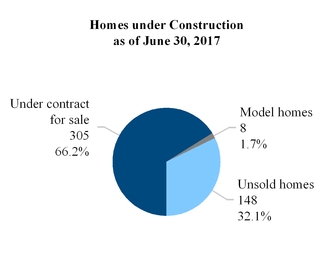
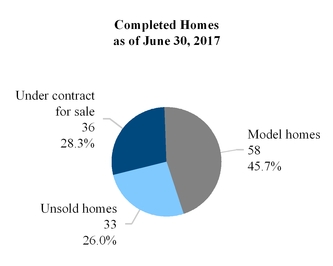
Our Business Environment and Current Outlook
During the three and six months ended June 30, 2017, the overall U.S. housing market continued to show signs of improvement, driven by factors such as continued supply and demand imbalance, low mortgage rates, employment growth and positive consumer confidence. Individual markets continue to experience varying results, as local home inventories, affordability and employment factors strongly influence local markets.
Homebuilding and land development are local businesses. As a result, we expect local market conditions will affect our community count, revenue and operating performance. Local market trends are the principal factors that impact our revenue and our revenue-related expenses. For example, when these trends are favorable, we expect our revenues from homebuilding and land development, as well as the expenses that vary with revenue, to generally increase; conversely, when these trends are negative, we expect our revenue and expenses that vary with revenue to generally decline, although in each case the impact may not be immediate or directly proportional. When trends are favorable, we expect to increase our community count by opening additional communities and expanding existing communities; conversely, when these trends are negative, we expect to reduce or maintain our community count or decrease the pace at which we open additional communities and expand existing communities.
Our operations for the three and six months ended June 30, 2017 reflect our continued focus on a number of initiatives, including growing our homebuilding operations and revenues (by seeking increased home sales at our existing communities), improving our gross margin percentage, improving our operating efficiency (by seeking to reduce non-revenue-related expenses as a percentage of revenue), and managing our balance sheet (by maintaining appropriate cash balances, real estate inventories and leverage).
We believe that our land position in markets where the approval process for land development and home construction is stringent and time consuming gives us a competitive advantage. We believe that by serving diverse market segments, including first-time, move-up, empty-nester, active-adult, and second-home buyers, mitigates the risk associated with any one market segment. We also believe that we operate in geographic markets that currently have strong housing fundamentals. These markets include the San Francisco Bay area, San Jose and the South Bay, Monterey, greater Los Angeles and the Central Valley areas of California, Seattle, Washington, Charlotte, North Carolina, Myrtle Beach, South Carolina and Nashville, Tennessee.
During the remainder of 2017, we intend to seek revenue growth and increased productivity from our homebuilding operations in both our West and Southeast operating segments, with significant focus on our Southeast operating divisions as well as our Pacific Northwest division as we work to fully leverage our operating expense investment. We also intend to continue our strategy of selectively buying and selling land when we believe that it is opportunistic to do so. We also intend to seek additional regional and corporate-level operating efficiencies. Additionally, we intend to maintain appropriate cash balances and liquidity in order to meet our obligations and provide growth capital for our operations.
35
RESULTS OF OPERATIONS
Consolidated Financial Data - For the Three and Six Months Ended June 30, 2017 and 2016
Three months ended June 30, | Six months ended June 30, | ||||||||||||||||||||||
(In thousands) | 2017 | 2016 | Change | 2017 | 2016 | Change | |||||||||||||||||
Revenue: | |||||||||||||||||||||||
Homebuilding | $ | 113,252 | $ | 81,415 | $ | 31,837 | $ | 207,255 | $ | 149,641 | $ | 57,614 | |||||||||||
Land development | — | 1,422 | (1,422 | ) | 496 | 1,422 | (926 | ) | |||||||||||||||
Total revenue | 113,252 | 82,837 | 30,415 | 207,751 | 151,063 | 56,688 | |||||||||||||||||
Cost of sales: | |||||||||||||||||||||||
Homebuilding | 91,337 | 66,370 | 24,967 | 167,991 | 122,576 | 45,415 | |||||||||||||||||
Land development | 102 | 225 | (123 | ) | 577 | 686 | (109 | ) | |||||||||||||||
Impairment on real estate | — | 2,397 | (2,397 | ) | 102 | 2,397 | (2,295 | ) | |||||||||||||||
Gross margin | 21,813 | 13,845 | 7,968 | 39,081 | 25,404 | 13,677 | |||||||||||||||||
Expenses: | |||||||||||||||||||||||
Sales and marketing | 6,219 | 4,667 | 1,552 | 11,368 | 8,743 | 2,625 | |||||||||||||||||
General and administrative | 9,883 | 7,234 | 2,649 | 18,385 | 14,509 | 3,876 | |||||||||||||||||
Total expenses | 16,102 | 11,901 | 4,201 | 29,753 | 23,252 | 6,501 | |||||||||||||||||
Income from operations | 5,711 | 1,944 | 3,767 | 9,328 | 2,152 | 7,176 | |||||||||||||||||
Other income | 38 | 22 | 16 | 498 | 49 | 449 | |||||||||||||||||
Net income before tax | $ | 5,749 | $ | 1,966 | $ | 3,783 | $ | 9,826 | $ | 2,201 | $ | 7,625 | |||||||||||
Provision for income taxes | (869 | ) | (141 | ) | (728 | ) | (1,491 | ) | (147 | ) | (1,344 | ) | |||||||||||
Net income | $ | 4,880 | $ | 1,825 | $ | 3,055 | $ | 8,335 | $ | 2,054 | $ | 6,281 | |||||||||||
Non-GAAP Financial Measures
In addition to results reported in accordance with GAAP, we have provided information in this quarterly report derived from our unaudited condensed consolidated financial statements not prepared in accordance with GAAP. These are considered non-GAAP financial measures and should be construed as supplemental information along with our financial statements prepared in accordance with GAAP. Specifically, we refer to the following non-GAAP financial measures in various sections of this report:
•Adjusted gross margin; and
•Net debt-to-capital ratio
Our reasons for the use of non-GAAP financial measures and reconciliations to the most directly comparable GAAP financial measure calculated and presented in accordance with GAAP are included below in this Management’s Discussion and Analysis of Financial Condition and Results of Operations.
36
Select Operating Metrics - For the Three and Six Months Ended June 30, 2017 and 2016
Net New Home Orders and Cancellation Rate

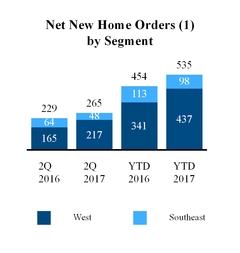
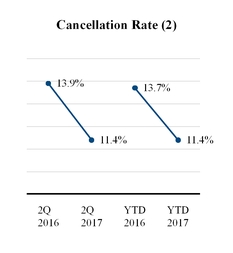
(1) “Net new home orders” refers to new home sales contracts reduced by the number of sales contracts canceled during the relevant period. (2) “Cancellation rate” refers to sales contracts canceled divided by sales contracts executed during the relevant period. |
Net new home orders during the three and six months ended June 30, 2017 increased by 36 and 81 homes, or 15.7% and 17.8%, respectively, as compared to the same periods in 2016. In our West operating segment, net new home orders increased 31.5% and 28.2% during the three and six months ended June 30, 2017, respectively, as compared to the same periods in 2016, primarily in our Bay Area, Central Valley and Southern California divisions as a result of strong demand. Our West operating segment continues to experience strong demand that is exceeding building capacity in many communities. As a result, we continue to limit sales to approximately a six-month supply of backlog.
Our Southeast operating segment experienced a decrease of 25.0% and 13.3% during the three and six months ended June 30, 2017, respectively, in net new home orders across all divisions as compared to the same periods in 2016. Currently, we are actively developing land so that we can open new communities for sale late in 2017 and in 2018. We intend to seek additional land purchases in our Southeast operating segment in 2017 to provide adequate land to increase new order activity.
37
Active Selling Communities and Absorption
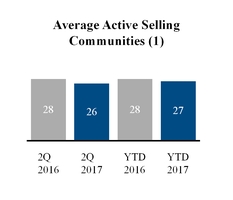

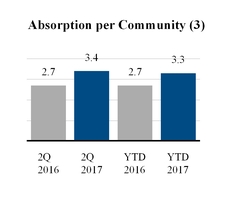
(1) “Average Active Selling Communities” refers to the average number of open selling communities at the end of each month during the period. (2) “Active Selling Communities” consists of those communities where we have more than 15 or more homes remaining to deliver. (3) “Absorption per Community” refers to the number of net new home orders sold per month in each active selling community for the period. |
The number of average active selling communities for the three and six months ended June 30, 2017 decreased by two and one, respectively, as compared to the same periods in 2016. During the three months ended June 30, 2017, we closed-out two communities, one in each of our Central Valley and Washington divisions and opened one new community in our Southern California division. In addition to the communities closed-out and opened during the three months ended June 30, 2017, we closed-out an additional two communities, one in each of our South Carolina and Tennessee divisions during the six months ended June 30, 2017.
For the three and six months ended June 30, 2017, we had 18 average active selling communities for both periods located in our West operating segment and eight and nine, respectively, in our Southeast operating segment. For the three and six months ended June 30, 2016, we had 18 average active selling communities located in our West operating segment and ten in our Southeast operating segment for both periods.
Absorption per community per month during the three and six months ended June 30, 2017 increased by 0.7 and 0.6 homes per community per month, respectively, as compared to the same periods in 2016. This was primarily due to growth in absorption to 2.0 and 1.8 homes per community per month in our Southeast operating segment during the three and six months ended June 30, 2017, and 4.0 homes per community per month in our West operating segment for both periods. Absorption per community per month during the three and six months ended June 30, 2016 was 3.1 and 3.2 homes, per community per month, respectively, in our West operating segment and 2.1 and 1.9 homes per community per month, respectively, in our Southeast operating segment.
38
Backlog - As of June 30, 2017


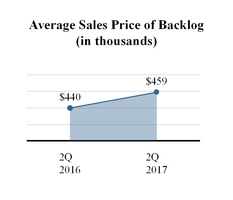
Our backlog value as of June 30, 2017 represented an increase of approximately $39.8 million, or 26.6%, as compared to our backlog value as of June 30, 2016. The increase as of June 30, 2017 was due to an increase of 73 unit homes in backlog and an increase of $19,000 in the ASP of homes in backlog as of June 30, 2017 as compared to June 30, 2016. The increase in the number of homes in backlog was a result of an increase of 67 homes in backlog in our West operating segment and an increase of six homes in backlog in our Southeast operating segment as of June 30, 2017 as compared to June 30, 2016.
The mix of homes in backlog between our two operating segments changed as of June 30, 2017 as compared to June 30, 2016 (as shown in the charts below):
Percentage of Homes in Backlog by Segment
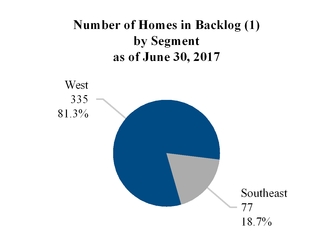
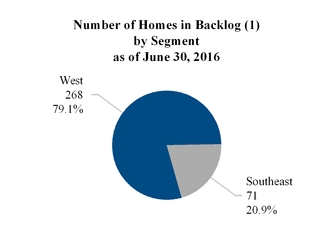
(1) | “Backlog” refers to homes under sales contracts that have not yet closed at the end of the relevant period. Sales contracts relating to homes in backlog may be canceled by the purchaser for a number of reasons, such as the prospective purchaser's inability to obtain mortgage financing. Upon a cancellation, the escrow deposit is returned to the prospective purchaser (other than with respect to certain design-related deposits, which we retain). Accordingly, backlog may not be indicative of our future revenue. |
39
Owned and Controlled Lots - As of June 30, 2017 and December 31, 2016
We owned or controlled, pursuant to purchase or option contracts, the number of lots set forth in the graphs below:
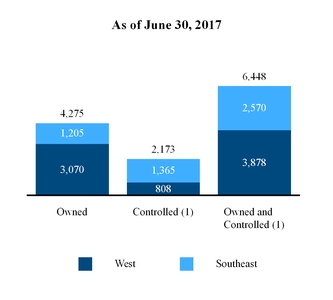
As of June 30, 2017, our total lots owned and controlled decreased by 190 lots since December 31, 2016. Total owned increased by 244 lots and total controlled decreased by 434 lots. On a segment basis, our West operating segment decreased the total owned and controlled lots by 197 lots and our Southeast operating segments increased the total owned and controlled lots by seven lots.
Of the 6,448 owned and controlled lots as of June 30, 2017, 747 lots were finished, 694 lots were under development, 3,071 lots were approved with primary entitlements and 1,865 lots were unentitled, of which 1,526 of the unentitled lots are under our control while we process entitlements, and 71 lots under contract for sale. This decrease in the number of controlled lots reflects our strategy of seeking to increase deliveries in our three Southeast divisions and the Pacific Northwest division in order to more fully leverage our operating expense investment. The decrease in owned lots during three and six months ended June 30, 2017 reflects our focus on managing our existing inventory across our geographies with a focus on improving our return metrics. On a segmented basis, our West operating segment decreased the number of owned lots by 135 and our Southeast operating segment increased the number of owned lots by 379. Our West operating segment decreased the number of controlled lots by 62 and our Southeast operating segments decreased the number of controlled lots by 372.
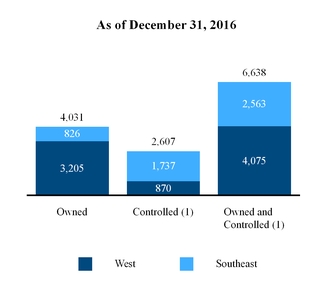
As of December 31, 2016, our total lots owned and controlled was 6,638 lots, of which 4,031 were owned and 2,607 were controlled. On a segment basis, our West operating segment consisted of 4,075 lots and our Southeast operating segment consisted of 2,563 lots.
Of the 6,638 owned and controlled lots as of December 31, 2016, 1,048 lots were finished, 1,083 lots were under development, 3,747 lots were approved with primary entitlements and 760 lots were unentitled, of which 635 of the unentitled lots are under our control while we process entitlements. Our number of controlled lots reflects our strategy of seeking to increase deliveries in our three Southeast divisions and the Pacific Northwest division in order to more fully leverage our operating expense investment. The number of owned lots as of December 31, 2016 reflects our focus on managing our existing inventory across our geographies with a focus on improving our return metrics. On a segmented basis, our West operating segment had 3,205 owned lots and 870 controlled lots. Our Southeast operating segment had 826 owned lots and 1,737 controlled lots.
(1) | Controlled lots are those subject to a purchase or option contract. |
40
Revenue
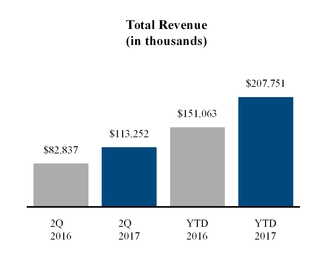
For the three months ended June 30, 2017, total revenue increased by $30.4 million, or 36.7%, as compared to the three months ended June 30, 2016. The increase in total revenue was the result of an increase of 62 homes in home deliveries and an increase of $6.2 million in the ASP of homes delivered during the three months ended June 30, 2017.
For the six months ended June 30, 2017, total revenue increased by $56.7 million, or 37.5%, as compared to the six months ended June 30, 2016. The increase in total revenue was the result of an increase of 121 homes in home deliveries, an increase of $7.9 million in the ASP of homes delivered during the six months ended June 30, 2017.
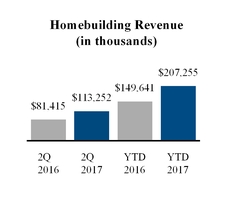
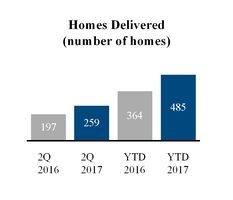
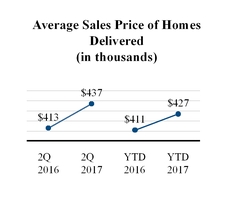
Homebuilding revenue for the three months ended June 30, 2017 increased by $31.8 million, or 39.1%, as compared to the three months ended June 30, 2016. The increase was primarily the result of a 31.5% increase in home deliveries and a 5.8% increase in the ASP of homes delivered to $437,000 during the three months ended June 30, 2017, as compared to the three months ended June 30, 2016. Of this revenue increase, $6.2 million was related to an increase in ASP and $25.6 million was related to the increase in homes delivered. The increase in ASP during the three months ended June 30, 2017 was primarily the result of an increase in the number of homes delivered in our West operating segment, which accounted for 76.4% of deliveries, or a 38.5% increase, during the three months ended June 30, 2017, as compared to the three months ended June 30, 2016.
For the six months ended June 30, 2017, homebuilding revenue increased by $57.6 million, or 38.5%, as compared to the six months ended June 30, 2016. The increase was primarily the result of a 33.2% increase in home deliveries and a 3.9% increase in the ASP of homes delivered to $427,000 during the six months ended June 30, 2017, as compared to the six months ended June 30, 2016. Of this revenue increase, $7.9 million was related to an increase in ASP and $49.7 million was related to the increase in homes delivered. The increase in ASP during the six months ended June 30, 2017 was primarily the result of an increase in the number of homes delivered in our West operating segment, which accounted for 74.0% of deliveries, or a 39.1% increase, during the six months ended June 30, 2017, as compared to the six months ended June 30, 2016.
41
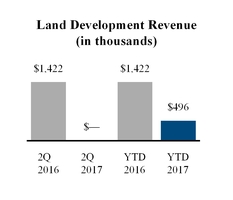
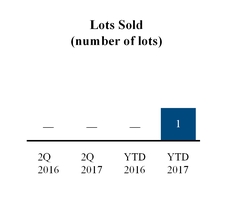

Land development revenue for the three months ended June 30, 2017 decreased by $1.4 million, as compared to the three months ended June 30, 2016. There was no land development revenue during the three months ended June 30, 2017. For the three and six months ended June 30, 2016, the $1.4 million in land development revenue was related to the sale of a parcel of land to a local utility district in Fresno, California.
For the six months ended June 30, 2017, land development revenue decreased by $0.9 million, as compared to the six months ended June 30, 2016. During six months ended June 30, 2017, land development consisted of the sale of one lot in our Red Hawk community and the recognition of deferred revenue in our Meadowood community, both located in Fresno County in California, during the first quarter of 2017.
Cost of Sales
Cost of sales in our homebuilding segment for the three months ended June 30, 2017 increased by $25.0 million, or 37.6%, as compared to the three months ended June 30, 2016. Of this increase, $21.0 million was due to the increase in the number of homes delivered and $3.9 million was due to the increase in the average cost per unit delivered and therefore cost per home sold during the three months ended June 30, 2017. In addition, $0.3 million of impairment was included in homebuilding cost of sales for the three and six months ended June 30, 2016.
For the six months ended June 30, 2017, cost of sales in our homebuilding segment increased by $45.4 million, or 37.1%, as compared to the six months ended June 30, 2016. Of this increase, $40.8 million was due to the increase in the number of homes delivered, $4.4 million was due to the increase in the average cost per unit delivered and therefore cost per home sold, and $0.1 million was due to real estate inventories impairment charges during the six months ended June 30, 2017.
Cost of sales in our land development segment for the three months ended June 30, 2017, decreased by $0.1 million as a result of no land sales and $0.1 million in abandonment charges as compared to the three months ended June 30, 2016..
For the six months ended June 30, 2017, cost of sales in our land development segment also decreased by $0.1 million, as compared to the six months ended June 30, 2016. Abandonment charges during the six months ended June 30, 2017 was $0.2 million.
We continuously evaluate our real estate inventories for impairment when conditions exist suggesting that the carrying amount of real estate inventories is not fully recoverable and may exceed its fair value.
Non-GAAP Financial Measures
We have provided information in this report relating to “adjusted gross margin” which is a non-GAAP financial measure. The most directly comparable GAAP financial measure is gross margin. We calculate adjusted gross margin from GAAP gross margin by adding back capitalized interest, and impairment and abandonment charges. We use adjusted gross margin information as a supplemental measure when evaluating our operating performance. We believe this information is meaningful, because it isolates the impact that leverage and non-cash impairment and abandonment charges have on gross margin. However, because adjusted gross margin information excludes interest expense, and impairment and abandonment charges, all of which have real economic effects and could materially impact our results, the utility of adjusted gross margin information as a measure of our operating performance is limited.
Other companies may not calculate adjusted gross margin information in the same manner that we do. Accordingly, adjusted gross margin information should be considered only as a supplement to gross margin information as a measure of our performance.
42
Gross Margin (“GM”) and Adjusted Gross Margin (“Adjusted GM”)
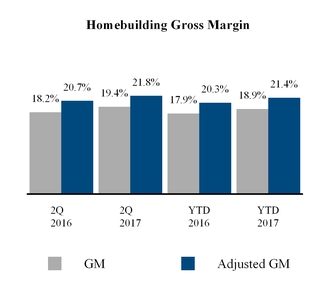
Homebuilding gross margin percentage during the three months ended June 30, 2017, increased 1.2%, as compared to the three months ended June 30, 2016. The increase in homebuilding gross margin during the three months ended June 30, 2017 was primarily due to: (1) our ability to move sales prices higher coupled with our ability to contain the impact of increasing labor and material costs, and (2) our ability to use sales price as a means to balance demand and our building capacity. Homebuilding adjusted gross margin percentage during the three months ended June 30, 2017 increased 1.1%, as compared to the three months ended June 30, 2016. The increase in homebuilding adjusted gross margin during the three months ended June 30, 2017 was primarily due to lower financing costs.
For the six months ended June 30, 2017, homebuilding gross margin percentage increased 1.0%, as compared to the six months ended June 30, 2016. Homebuilding adjusted gross margin percentage during the six months ended June 30, 2017 increased 1.1%, as compared to the six months ended June 30, 2016.
Land Development Gross Margin
For the three months ended June 30, 2017, we did not sell any land, but recognized $0.1 million in abandonment charges, included as part of cost of sales - land development, in our Southeast operating segment. Land development gross margin and adjusted gross margin percentages during the three months ended June 30, 2016 were negative 65.7% and positive 98.3%, respectively, primarily due to $2.4 million in real estate impairment charges in our Sundance community located in Bakersfield, California, (“Sundance ”) and $0.1 million in abandonment charges, both included as part of cost of land development.
Land development gross margin and adjusted gross margin percentages during the six months ended June 30, 2017 were negative 16.3% and positive 27.0%, respectively, as compared to negative 98.1% and positive 95.4% during the six months ended June 30, 2016, respectively. For the six months ended June 30, 2017, $0.2 million in abandonment charges were included as part of cost of sales - land development. For the six months ended June 30, 2016, cost of sales - land development included the real estate impairment charge on our Sundance community coupled with a decision to abandon a number of land acquisition opportunities.
43
The following table provides a reconciliation of adjusted gross margin information to gross margin information the most comparable GAAP financial measure:
Three Months Ended June 30, | Six Months Ended June 30, | ||||||||||||||||||||||||||
(Dollars in thousands) | 2017 | % | 2016 | % | 2017 | % | 2016 | % | |||||||||||||||||||
Consolidated Gross Margin & Adjusted Gross Margin | |||||||||||||||||||||||||||
Revenue | $ | 113,252 | 100.0 | % | $ | 82,837 | 100.0 | % | $ | 207,751 | 100.0 | % | $ | 151,063 | 100.0 | % | |||||||||||
Cost of sales | 91,439 | 80.7 | % | 68,992 | 83.3 | % | 168,670 | 81.2 | % | 125,659 | 83.2 | % | |||||||||||||||
Gross margin | 21,813 | 19.3 | % | 13,845 | 16.7 | % | 39,081 | 18.8 | % | 25,404 | 16.8 | % | |||||||||||||||
Add: interest in cost of sales | 2,735 | 2.4 | % | 1,936 | 2.3 | % | 5,095 | 2.5 | % | 3,475 | 2.3 | % | |||||||||||||||
Add: impairment and abandonment charges | 102 | 0.1 | % | 2,452 | 3.0 | % | 306 | 0.1 | % | 2,871 | 1.9 | % | |||||||||||||||
Adjusted gross margin(1) | $ | 24,650 | 21.8 | % | $ | 18,233 | 22.0 | % | $ | 44,482 | 21.4 | % | $ | 31,750 | 21.0 | % | |||||||||||
Consolidated gross margin percentage | 19.3 | % | 16.7 | % | 18.8 | % | 16.8 | % | |||||||||||||||||||
Consolidated adjusted gross margin percentage(1) | 21.8 | % | 22.0 | % | 21.4 | % | 21.0 | % | |||||||||||||||||||
Homebuilding Gross Margin & Adjusted Gross Margin | |||||||||||||||||||||||||||
Homebuilding revenue | $ | 113,252 | 100.0 | % | $ | 81,415 | 100.0 | % | $ | 207,255 | 100.0 | % | $ | 149,641 | 100.0 | % | |||||||||||
Cost of home sales | 91,337 | 80.6 | % | 66,636 | 81.8 | % | 168,093 | 81.1 | % | 122,842 | 82.1 | % | |||||||||||||||
Homebuilding gross margin | 21,915 | 19.4 | % | 14,779 | 18.2 | % | 39,162 | 18.9 | % | 26,799 | 17.9 | % | |||||||||||||||
Add: interest in cost of home sales | 2,735 | 2.4 | % | 1,790 | 2.2 | % | 5,084 | 2.5 | % | 3,329 | 2.2 | % | |||||||||||||||
Add: impairment and abandonment charges | — | — | % | 266 | 0.3 | % | 102 | — | % | 266 | 0.2 | % | |||||||||||||||
Adjusted homebuilding gross margin(1) | $ | 24,650 | 21.8 | % | $ | 16,835 | 20.7 | % | $ | 44,348 | 21.4 | % | $ | 30,394 | 20.3 | % | |||||||||||
Homebuilding gross margin percentage | 19.4 | % | 18.2 | % | 18.9 | % | 17.9 | % | |||||||||||||||||||
Adjusted homebuilding gross margin percentage(1) | 21.8 | % | 20.7 | % | 21.4 | % | 20.3 | % | |||||||||||||||||||
Land Development Gross Margin & Adjusted Gross Margin | |||||||||||||||||||||||||||
Land development revenue | $ | — | — | % | $ | 1,422 | 100.0 | % | $ | 496 | 100.0 | % | $ | 1,422 | 100.0 | % | |||||||||||
Cost of land development sales | 102 | — | % | 2,356 | 165.7 | % | 577 | 116.3 | % | 2,817 | 198.1 | % | |||||||||||||||
Land development gross margin | (102 | ) | — | % | (934 | ) | (65.7 | )% | (81 | ) | (16.3 | )% | (1,395 | ) | (98.1 | )% | |||||||||||
Add: interest in cost of land development | — | — | % | 146 | 10.3 | % | 11 | 2.2 | % | 146 | 10.3 | % | |||||||||||||||
Add: impairment and abandonment charges | 102 | — | % | 2,186 | 153.7 | % | 204 | 41.1 | % | 2,605 | 183.2 | % | |||||||||||||||
Adjusted land development gross margin(1) | $ | — | — | % | $ | 1,398 | 98.3 | % | $ | 134 | 27.0 | % | $ | 1,356 | 95.4 | % | |||||||||||
Land development gross margin percentage | — | % | (65.7 | )% | (16.3 | )% | (98.1 | )% | |||||||||||||||||||
Adjusted land development gross margin percentage(1) | — | % | 98.3 | % | 27.0 | % | 95.4 | % | |||||||||||||||||||
* | Percentages may not add due to rounding. |
(1) | Adjusted gross margin, adjusted homebuilding gross margin and adjusted land development gross margin are non-GAAP financial measures. |
44
Sales and Marketing, and General and Administrative Expenses
Our operating expenses for the three and six months ended June 30, 2017 and 2016 were as follows:
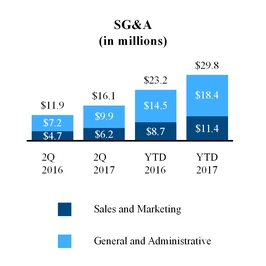
As a percentage of total revenue | ||||||||||||
Three months ended June 30, | Six months ended June 30, | |||||||||||
2017 | 2016 | 2017 | 2016 | |||||||||
Sales and marketing | 5.5 | % | 5.6 | % | 5.5 | % | 5.8 | % | ||||
G&A | 8.7 | % | 8.7 | % | 8.8 | % | 9.6 | % | ||||
Total SG&A | 14.2 | % | 14.4 | % | 14.3 | % | 15.4 | % | ||||
* Percentages may not add due to rounding. | ||||||||||||
Sales and marketing expense for the three and six months ended June 30, 2017 increased approximately $1.6 million and $2.6 million, respectively, or 33.3% and 30.0%, respectively, as compared to the three and six months ended June 30, 2016. The increase in sales and marketing expense during the three and six months ended June 30, 2017 was primarily attributable to the increase of 31.5% and 33.2%, respectively, in the number of homes delivered and the associated commission and closing cost expenses on these deliveries, most notably in our West operating segment. As a percentage of total revenue, sales and marketing expenses slightly decreased primarily due to the 36.7% and 37.5% increase in total revenue during the three and six months ended June 30, 2017, respectively, as compared to the three and six months ended June 30, 2016.
G&A expenses for the three and six months ended June 30, 2017 increased by approximately $2.6 million and $3.9 million, respectively, or 36.6% and 26.7%, respectively, as compared to the three and six months ended June 30, 2016. The primary reason for the increase in G&A expense during the three and six months ended June 30, 2017 was an increase in bonus expense as a result of the Company’s increased earnings during the quarter coupled with an increase in legal fees outside the ordinary course of business, including the merger agreement with Century Communities. For the three and six months ended June 30, 2016, G&A expense included increased compensation expense as a result of severance expense and bonus accrual partially offset by a decline in stock based compensation expense.
As a percentage of revenue, G&A expenses remained constant at 8.7% for the three months ended June 30, 2017 as compared to the three months ended June 30, 2016. For the six months ended June 30, 2017, G&A expenses as a percentage of revenue decreased by 8.3% primarily due to the revenue growth and our continued focus to manage G&A expenses tightly. Excluding the legal fees outside the ordinary course of business of $1.7 million and $2.1 million during the three and six months ended June 30, 2017, respectively, G&A expenses as a percentage of revenue would have been 7.2% and 7.8%, respectively, a decrease by 17.2% and 18.8%, respectively, as compared to the three and six months ended June 30, 2016.
Other Income
Other income during the three and six months ended June 30, 2017 increased by approximately $16,000 and $449,000, respectively, as compared to the three and six months ended June 30, 2016, primarily due to the extinguishment of debt.
Provision for Income Taxes
For the three and six months ended June 30, 2017, a provision for income taxes of $0.9 million and $1.5 million, respectively, were recorded as compared to $141,000 and $147,000 for the three and six months ended June 30, 2016, respectively. The difference in the amount of taxes recorded period over period is driven primarily as a result of the full valuation allowance we maintained on our deferred tax assets as of June 30, 2016. As of December 31, 2016 we concluded that it was more likely than not that we would realize the benefit of our deferred tax assets and, as such, the valuation allowance was reversed. See Note 12, “Income Taxes” and Note 1, “Organization, Basis of Presentation and Summary of Significant Accounting Policies--Income Taxes” to the accompanying unaudited condensed consolidated financial statements included elsewhere in this report for a further discussion of income taxes.
45
Net Income and Earnings per Share of Class A Common Stock
Our net income and earnings per share of Class A common stock for the three and six months ended June 30, 2017 and 2016 were as follows:
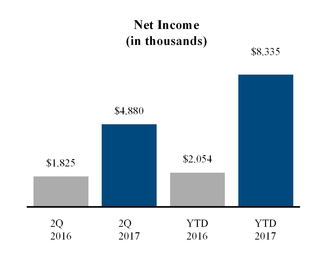
As a result of the foregoing factors, our net income for the three and six months ended June 30, 2017 increased $3.1 million and $6.3 million, respectively, as compared to the three and six months ended June 30, 2016.

Net income attributable to UCP, Inc. for the three and six months ended June 30, 2017 increased $0.9 million and $2.0 million, respectively, as compared to the three and six months ended June 30, 2016.
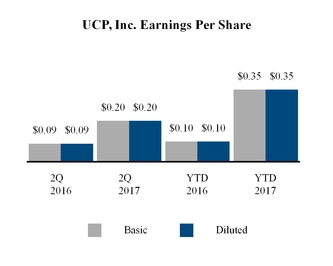
EPS of UCP, Inc. Class A common stock for the three months ended June 30, 2017 was $0.20 per basic and $0.20 per diluted share, as compared to $0.09 per basic share and diluted share for the three months ended June 30, 2016.
For the six months ended June 30, 2017, EPS of UCP, Inc. Class A common stock was $0.35 per basic share and diluted share, as compared to $0.10 per basic share and diluted share during six months ended June 30, 2016.
46
REPORTING SEGMENTS
The Company periodically evaluates its homebuilding and land development operations in an effort to allocate resources properly. Based on this evaluation, the Company has classified its operating activities into two operating segments, West and Southeast, and two reportable segments, Homebuilding and Land development. See Note 10, “Segment Information” to the accompanying unaudited condensed consolidated financial statements included elsewhere in this report. The following table presents financial information related to our homebuilding and land development reporting segments for the periods indicated:
Three months ended June 30, | |||||||||||||||||||||
2017 | 2016 | ||||||||||||||||||||
(Dollars in thousands) | Revenues | Gross Margin | GM % | Revenues | Gross Margin | GM % | |||||||||||||||
Homebuilding | |||||||||||||||||||||
West | $ | 95,798 | $ | 19,545 | 20.4 | % | $ | 68,015 | $ | 12,708 | 18.7 | % | |||||||||
Southeast | 17,454 | 2,370 | 13.6 | % | 13,400 | 2,071 | 15.5 | % | |||||||||||||
Total homebuilding | 113,252 | 21,915 | 19.4 | % | 81,415 | 14,779 | 18.2 | % | |||||||||||||
Land development | |||||||||||||||||||||
West | — | — | — | % | 1,422 | (884 | ) | (62.2 | )% | ||||||||||||
Southeast | — | (102 | ) | — | % | — | (50 | ) | — | % | |||||||||||
Total land development | — | (102 | ) | — | % | 1,422 | (934 | ) | (65.7 | )% | |||||||||||
Total | $ | 113,252 | $ | 21,813 | 19.3 | % | $ | 82,837 | $ | 13,845 | 16.7 | % | |||||||||
Six months ended June 30, | |||||||||||||||||||||
2017 | 2016 | ||||||||||||||||||||
(Dollars in thousands) | Revenues | Gross Margin | GM % | Revenues | Gross Margin | GM % | |||||||||||||||
Homebuilding | |||||||||||||||||||||
West | $ | 172,768 | $ | 34,234 | 19.8 | % | $ | 124,774 | $ | 23,022 | 18.5 | % | |||||||||
Southeast | 34,487 | 4,928 | 14.3 | % | 24,867 | 3,777 | 15.2 | % | |||||||||||||
Total homebuilding | 207,255 | 39,162 | 18.9 | % | 149,641 | 26,799 | 17.9 | % | |||||||||||||
Land development | |||||||||||||||||||||
West | 496 | 41 | 8.3 | % | 1,422 | (1,006 | ) | (70.7 | )% | ||||||||||||
Southeast | — | (122 | ) | — | % | — | (389 | ) | — | % | |||||||||||
Total land development | 496 | (81 | ) | (16.3 | )% | 1,422 | (1,395 | ) | (98.1 | )% | |||||||||||
Total | $ | 207,751 | $ | 39,081 | 18.8 | % | $ | 151,063 | $ | 25,404 | 16.8 | % | |||||||||
As previously discussed, the higher gross margin for the three and six months ended June 30, 2017, as compared to the same period in 2016, was the result of the Company’s ability to raise sales prices in excess of cost increases.
47
Homebuilding Operations
The following charts and tables present information concerning homes delivered, ASP and revenue for our homebuilding operations by our West and Southeast operating segments for the three and six months ended June 30, 2017 and 2016:
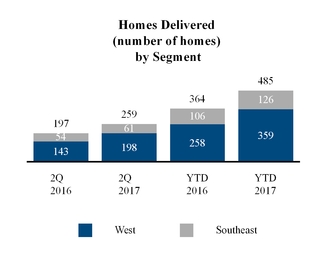

The increase in the ASP of a home delivered in our West operating segment during the three months ended June 30, 2017 was largely a result of product and geographic mix with an increase in the percentage of total homes delivered to 76.4% from 72.6% in the prior period.
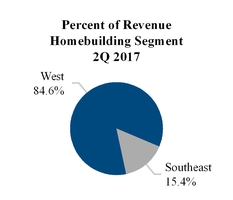
Three Months Ended June 30, 2017 | |||||||||||||||||
Segment | Homebuilding Revenue (in thousands) | % of Total Homebuilding Revenue | Homes Delivered | % of Total Homes Delivered | ASP (in thousands) | ||||||||||||
West | $ | 95,798 | 84.6 | % | 198 | 76.4 | % | $ | 484 | ||||||||
Southeast | 17,454 | 15.4 | % | 61 | 23.6 | % | 286 | ||||||||||
Total | $ | 113,252 | 100.0 | % | 259 | 100.0 | % | $ | 437 | ||||||||
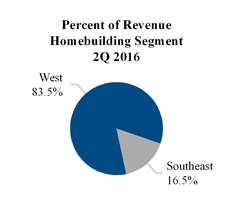
Three Months Ended June 30, 2016 | |||||||||||||||||
Segment | Homebuilding Revenue (in thousands) | % of Total Homebuilding Revenue | Homes Delivered | % of Total Homes Delivered | ASP (in thousands) | ||||||||||||
West | $ | 68,015 | 83.5 | % | 143 | 72.6 | % | $ | 476 | ||||||||
Southeast | 13,400 | 16.5 | % | 54 | 27.4 | % | 248 | ||||||||||
Total | $ | 81,415 | 100.0 | % | 197 | 100.0 | % | $ | 413 | ||||||||
48

Six Months Ended June 30, 2017 | |||||||||||||||||
Segment | Homebuilding Revenue (in thousands) | % of Total Homebuilding Revenue | Homes Delivered | % of Total Homes Delivered | ASP (in thousands) | ||||||||||||
West | $ | 172,768 | 83.4 | % | 359 | 74.0 | % | $ | 481 | ||||||||
Southeast | 34,487 | 16.6 | % | 126 | 26.0 | % | 274 | ||||||||||
Total | $ | 207,255 | 100.0 | % | 485 | 100.0 | % | $ | 427 | ||||||||
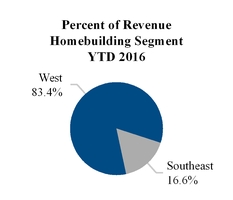
Six Months Ended June 30, 2016 | |||||||||||||||||
Segment | Homebuilding Revenue (in thousands) | % of Total Homebuilding Revenue | Homes Delivered | % of Total Homes Delivered | ASP (in thousands) | ||||||||||||
West | $ | 124,774 | 83.4 | % | 258 | 70.9 | % | $ | 484 | ||||||||
Southeast | 24,867 | 16.6 | % | 106 | 29.1 | % | 235 | ||||||||||
Total | $ | 149,641 | 100.0 | % | 364 | 100.0 | % | $ | 411 | ||||||||
For the three and six months ended June 30, 2017 and 2016, our West operating segment accounted for a majority of the percentage of homes closed. For the three and six months ended June 30, 2017, the increase in the percentage of homes closed in our West and Southeast operating segments reflect continued strong demand into 2017.
49
Land Development Operations
The following chart and table presents information concerning revenues and lots sold for our land development operations by our West and Southeast operating segments:

Three months ended June 30, | Six months ended June 30, | |||||||||||||||||||||||||||
2017 | 2016 | 2017 | 2016 | |||||||||||||||||||||||||
Segment | Land Development Revenue (in thousands) | Lots Sold | Land Development Revenue (in thousands) | Lots Sold | Land Development Revenue (in thousands) | Lots Sold | Land Development Revenue (in thousands) | Lots Sold | ||||||||||||||||||||
West | $ | — | — | $ | 1,422 | — | $ | 496 | 1 | $ | 1,422 | — | ||||||||||||||||
Southeast | — | — | — | — | — | — | — | — | ||||||||||||||||||||
Total | $ | — | — | $ | 1,422 | — | $ | 496 | 1 | $ | 1,422 | — | ||||||||||||||||
For the six months ended June 30, 2017, our West operating segment accounted for the one lot sold. For the three and six months ended June 30, 2016, land development revenue was related to the sale of a parcel of land to a local utility district in Fresno, California.
LIQUIDITY AND CAPITAL RESOURCES
Our principal uses of capital for the three and six months ended June 30, 2017 and 2016 are funding our operating expenses, investing activities (principally acquiring and developing land, and building homes) and repaying liabilities. Our principal sources of liquidity are cash on hand, cash provided by operations and cash provided by financing activities (such as acquisition, development and construction financing). As of June 30, 2017, we had approximately $32.1 million of cash and cash equivalents, which includes $1.5 million of restricted cash. We also had available borrowing capacity on our acquisition, development and construction financing of $84.6 million, of which $12.8 million was immediately available and the remaining balance is available to fund project specific development activities as those progress during 2017.
Our 2017 Senior Notes with $75 million in principal outstanding mature in October of 2017, and an additional $30.1 million in acquisition, development and construction (“ADC”) loans are also set to mature in the ordinary course of business. With respect to the $30.1 million in ADC loans maturing in 2017, these loans are project specific loans and are scheduled to mature in the ordinary course of closing out of the sales phase for each of these projects and we anticipate the sales proceeds from the designated home closings will provide a more than adequate source of cash for the repayment of these loans.
We also believe that we have access to new sources of capital, as needed, to fund further investment in our business for land acquisitions and new development activities. As of June 30, 2017, our Debt to Total Capital and Net Debt to Total Capital, was 40.6% and 38.1%, respectively, providing us with significant financial flexibility.
50
Long-term Funding Strategy
Our funding strategy contemplates the use of debt and the reinvestment of cash from operations. We generally attempt to match the duration of our real estate assets with the duration of the capital that finances each real estate asset. We generally look to finance our homes under construction, which have a short duration, with a combination of long-term capital (equity and long-term debt) and short-term bank financing. We generally look to finance our finished lots that will be put in production within one year, and therefore have a short duration, with a combination of long-term capital (equity and long-term debt) and short-term bank financing. We generally look to finance our assets with a long duration, such as land held for future development or finished lots that will not be put into production for more than one year, with long-term capital (equity and long-term debt).
Senior Notes
The 2017 Notes were issued under an Indenture, dated as of October 21, 2014 (the “Indenture”) and are guaranteed on an unsecured senior basis by each of our subsidiaries (the “Subsidiary Guarantors”). The Senior Notes and the guarantees are the Company’s, and the Subsidiary Guarantors’, senior unsecured obligations and rank equally in right of payment with all of our and the Subsidiary Guarantors’ existing and future senior unsecured debt and senior in right of payment to all of our and the Subsidiary Guarantors’ future subordinated debt. The 2017 Notes and the guarantees are effectively subordinated to any of our and the Subsidiary Guarantors’ existing and future secured debt, to the extent of the value of the assets securing such debt.
We may redeem the 2017 Notes, in whole but not in part, at any time at a price equal to 100% of the principal amount, plus accrued and unpaid interest, plus an “applicable” premium.
The Indenture provides for customary “events of default” which could cause, or permit, the acceleration of the 2017 Notes. Such events of default include: (i) a default in any payment of principal or interest on the 2017 Notes; (ii) failure to comply with certain covenants contained in the Indenture; (iii) defaults under certain other indebtedness or the acceleration of certain other indebtedness prior to maturity; (iv) the failure to pay certain final judgments; and (vi) certain events of bankruptcy or insolvency.
The Indenture limits our and our subsidiaries’ ability to, among other things, incur or guarantee additional unsecured and secured indebtedness (provided that we may incur indebtedness so long as our ratio of indebtedness to consolidated tangible assets (on a pro forma basis) would be equal to or less than 45% and provided that the aggregate amount of secured debt may not exceed the greater of $75 million or 30% of our consolidated tangible assets); pay dividends and make certain investments and other restricted payments, including purchase of our stock; acquire unimproved real property in excess of $75 million per fiscal year or in excess of $150 million over the term of the 2017 Notes, except to the extent funded with subordinated obligations or the proceeds of equity issuances; create or incur certain liens; transfer or sell certain assets; and merge or consolidate with other companies or transfer or sell all or substantially all of our consolidated assets.
Additionally, the Indenture requires us to: (i) maintain at least $50 million of consolidated tangible assets not subject to liens securing indebtedness (the “Minimum Unlevered Asset Pool Test”); (ii) maintain a minimum net worth of at least $175 million (the “Minimum Net Worth Test”); (iii) maintain a minimum of $15 million of unrestricted cash and/or cash equivalents (the “Minimum Liquidity Test”); and (iv) not permit decreases in the amount of consolidated tangible assets by more than $25 million in any fiscal year or more than $50 million at any time after the issuance of the 2017 Notes (the “Consolidated Tangible Assets Test”).
The foregoing is only a brief description of the 2017 Notes and is qualified in its entirety by reference to the Indenture.
As set forth below, as of June 30, 2017, we were in compliance with each of the Minimum Unlevered Asset Pool Test, the Minimum Net Worth Test, the Minimum Liquidity Test and the Consolidated Tangible Assets Test. Capitalized terms used in the following table shall have the meanings assigned thereto in the Indenture.
51
(In thousands, except percentages) | As of June 30, 2017 | Requirement | |||
Minimum Unlevered Asset Pool Test | |||||
Consolidated tangible assets | $ | 422,857 | |||
Consolidated tangible assets subject to liens (1) | 205,791 | ||||
Consolidated tangible assets not subject to liens (1) | $ | 217,066 | ≥ $ 50,000 | ||
Minimum Net Worth Test | |||||
Consolidated tangible assets | $ | 422,857 | |||
Total indebtedness | 159,565 | ||||
Net worth | $ | 263,292 | ≥ $ 175,000 | ||
Minimum Liquidity Test | |||||
Cash and cash equivalents | $ | 32,057 | |||
Restricted cash (2) | 1,547 | ||||
Unrestricted cash and cash equivalents (2) | $ | 30,510 | ≥ $ 15,000 | ||
Consolidated Tangible Assets Test | Requirement | ||||
Consolidated tangible assets as of June 30, 2017 | $ | 422,857 | |||
Consolidated tangible assets as of January 1, 2017 | 414,138 | ||||
Increase in consolidated tangible assets during 2017 (3) | $ | 8,719 | Δ ≥ ( $25,000) | ||
Consolidated tangible assets as of June 30, 2017 | $ | 422,857 | |||
Consolidated tangible assets as of October 21, 2014 | 293,784 | ||||
Increase in consolidated tangible assets since October 21, 2014 (3)(4) | $ | 129,073 | Δ ≥ ($50,000) | ||
Funded Debt to Tangible Assets Ratio Test | |||||
Funded debt as of June 30, 2017 | $ | 159,565 | |||
Consolidated tangible assets as of June 30, 2017 | 422,857 | ||||
Funded debt to tangible assets ratio | 38 | % | ≤ 45% | ||
(1) | “Liens,” as used in this table, means Liens other than Liens of the type described in clauses (b), (c), (e), (f), (h), (i), (j), (t), (v), (w), (x) and (y) of the definition of “Permitted Liens” under the Indenture. In general, this excludes certain Liens securing obligations that are not indebtedness for money borrowed. |
(2) | Unrestricted cash and cash equivalents excludes restricted cash and other restricted cash balance requirements. Restricted cash excludes the $15 million requirement under the Indenture for purposes of the tests shown above. |
(3) | We may not permit our Consolidated Tangible Assets to decrease by more than $25 million in any fiscal year or more than $50 million in the aggregate at any time after October 21, 2014 (i.e. the date of issue of the 2017 Notes). |
(4) | Based on Consolidated Tangible Assets as of September 30, 2014, the end of the quarter immediately preceding the issue of the 2017 Notes. |
In addition, (i) as of June 30, 2017 no Default or Event of Default (as such terms are defined in the Indenture) had occurred under the Indenture; (ii) all Asset Dispositions (as defined in the Indenture) made under the “Asset Disposition” covenant contained in the Indenture (Section 3.10) during the three months ended June 30, 2017 were made in compliance with such covenant; and (iii) any Restricted Payments (as defined in the Indenture) made during the three months ended June 30, 2017 complied in all respects with the requirements of the “Restricted Payments” covenant contained in the Indenture (Section 3.19).
52
Non-GAAP Financial Measure
In addition to the results reported in accordance with GAAP, we have provided information in this report relating to “net debt-to-capital ratio” which is a non-GAAP financial measure. The most directly comparable GAAP financial measure is the ratio of debt-to-capital. We believe that our leverage ratios provide useful information to the users of our financial statements regarding our financial position and cash and debt management.
The ratio of net debt-to-capital is computed as the quotient obtained by dividing net debt (which is debt less unrestricted cash and cash equivalents) by the sum of net debt plus stockholders’ and member's equity. We believe the ratio of net debt-to-capital is a relevant financial measure for investors to understand the leverage employed in our operations and as an indicator of our ability to obtain financing. We reconcile this non-GAAP financial measure to the ratio of debt-to-capital in the table above.
In addition, other companies may not calculate net debt-to-capital ratios in the same manner that we do. Accordingly, the net debt-to-capital ratio should be considered only as a supplement to the ratio of debt-to-capital information as a measure of our financial leverage.
Debt-to-Capital and Net Debt-to-Capital Ratios
The following table provides a reconciliation of our net debt-to-capital ratio to the most comparable GAAP financial measure:
(Dollars in thousands) | As of June 30, 2017 | As of December 31, 2016 | |||||
Debt | $ | 159,565 | $ | 160,994 | |||
Equity | 233,752 | 226,886 | |||||
Total capital | $ | 393,317 | $ | 387,880 | |||
Ratio of debt-to-capital | 40.6 | % | 41.5 | % | |||
Debt | $ | 159,565 | $ | 160,994 | |||
Net cash and cash equivalents | $ | 32,057 | $ | 42,478 | |||
Less: restricted cash and minimum liquidity requirement | 16,547 | 16,547 | |||||
Unrestricted cash and cash equivalents | $ | 15,510 | $ | 25,931 | |||
Net debt | $ | 144,055 | $ | 135,063 | |||
Equity | 233,752 | 226,886 | |||||
Total adjusted capital | $ | 377,807 | $ | 361,949 | |||
Ratio of net debt-to-capital (1) | 38.1 | % | 37.3 | % | |||
(1) | The ratio of net debt-to-capital is a non-GAAP financial measure. |
53
Cash Flows - Six Months Ended June 30, 2017 Compared to Six Months Ended June 30, 2016
Our comparison of cash flows for the six months ended June 30, 2017, as compared to the six months ended June 30, 2016, is as follow (in thousands):
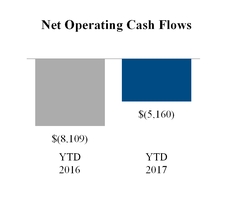
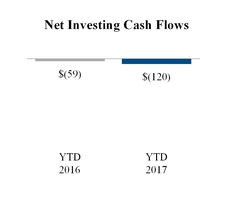
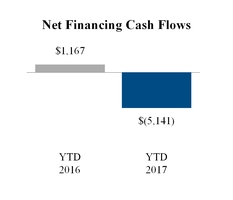
Cash flows used in operating activities decreased by $2.9 million as compared to 2016 primarily due to the following:
• | We generated $9.6 million of net income before non-cash expenses of stock-based compensation, impairment and abandonment charges on real estate inventories, as well as, depreciation and amortization as compared to net income before non-cash expenses of $5.7 million for the same period during 2016. |
• | We used $17.8 million to finance an increase in real estate inventories, an increase of $2.1 million as compared to the same period during 2016. The increase in inventories was primarily attributable to a $31.5 million increase in the amount of homes completed or under construction and $17.5 million increase in the amount of land held and land under development, partially offset by a $32.2 million decrease in finished lots during the 2017 period. As of June 30, 2017, we had 588 homes in inventory as compared to 492 homes in inventory as of June 30, 2016. |
• | We generated $1.6 million in other assets and receivables during the six months ended June 30, 2017, as compared to $0.3 million we used to finance growth in other assets and receivables during the same period in 2016. |
Cash flows used in investing activities increased $0.1 million as compared to 2016 primarily due to the following:
• | We increased our purchases of fixed assets by $0.1 million during the six months ended June 30, 2017, as compared to the same period in 2016. |
Cash flows used in financing activities increased $6.3 million as compared to 2016 primarily due to the following:
• | We decreased our net borrowings by $8.1 million as compared to the same period in 2016. The net borrowings during the six months ended June 30, 2017 were proceeds from acquisition, development and construction loans which totaled $84.1 million while repayments on these loans totaled $85.8 million. |
• | We incurred $1.2 million in debt issuance costs for the six months ended June 30, 2017, as compared to $0.1 million for the same period during 2016. |
• | We paid $1.9 million in a cash tax distribution to our noncontrolling interest (i.e. PICO) during the six months ended June 30, 2017. For the same period in 2016, we paid $4.8 million in a cash tax distribution to our noncontrolling interest. |
As of June 30, 2017, our cash, cash equivalents and restricted cash balance was $32.1 million.
54
OFF-BALANCE SHEET ARRANGEMENTS AND CONTRACTUAL OBLIGATIONS
Our off-balance sheet arrangements and contractual obligations have been disclosed in the accompanying unaudited condensed consolidated financial statements as noted below:
Land Purchase and Land Option Contracts
For information regarding our land purchase and land option contracts, see Note 11, “Commitments and Contingencies--Purchase Commitments” to the accompanying unaudited condensed consolidated financial statements included elsewhere in this report.
Loan Commitments
For information regarding our debt, see Note 7, “Notes Payable and Senior Notes, net” to the accompanying unaudited condensed consolidated financial statements included elsewhere in this report.
Surety Bonds
For information regarding our surety bonds, see Note 11, “Commitments and Contingencies--Surety Bonds” to the accompanying unaudited condensed consolidated financial statements included elsewhere in this report.
INFLATION AND SEASONALITY
Inflation
Our business can be adversely impacted by inflation, primarily from higher land, financing, labor, material and construction costs. In addition, inflation can lead to higher mortgage rates, which can significantly affect the affordability of mortgage financing to home buyers. While we attempt to pass on cost increases to customers through increased prices, when weak housing market conditions exist, we are often unable to offset cost increases with higher selling prices. Additionally, rising mortgage rates may result in a decrease in the number of homes we sell and a reduction in selling prices.
Seasonality
Historically, the homebuilding industry experiences seasonal fluctuations in quarterly operating results and capital requirements. We typically experience the highest new home order activity in spring and summer, although this activity is also highly dependent on the number of active selling communities, the timing of new community openings and other market factors. Since it typically takes four to six months to construct a new home, we generally deliver more homes in the second half of the year as spring and summer home orders convert to home deliveries. Because of this seasonality, home starts, construction costs and related cash outflows have historically been highest in the second and third quarters, and the majority of cash receipts from home deliveries occur during the second half of the year. We expect this seasonal pattern to continue over the long-term, although it may be affected by volatility in the homebuilding industry.
RECENT ACCOUNTING PRONOUNCEMENTS
See Note 1, “Organization, Basis of Presentation and Summary of Significant Accounting Policies” to the accompanying unaudited condensed consolidated financial statements included elsewhere in this report regarding the impact of certain recent accounting pronouncements on our accompanying unaudited condensed consolidated financial statements.
55
ITEM 3. QUANTITATIVE AND QUALITATIVE DISCLOSURE ABOUT MARKET RISK
Market risk includes risks that arise from changes in interest rates, equity prices and other market changes that affect market sensitive instruments. Our primary market risk related to fluctuations in interest rates on our variable interest rate debt, which consists of our secured acquisition, construction and development loans. As of June 30, 2017, we had approximately $78.0 million of variable interest rate debt outstanding (or 48.8% of total indebtedness) with a weighted average interest rate of 4.80% per annum. If interest rates on our variable interest rate debt increase or decrease by 0.1 percent, our interest expense will increase or decrease by approximately $78,000. We did not hedge our exposure to changes in interest rates with swaps, forward or option contracts on interest rates, or other types of derivative financial instruments during the three months ended June 30, 2017. However, we may choose to hedge our exposure to changes in interest rates with these or other types of instruments in the future if, for example, we incur significant amounts of additional variable rate debt. We have not entered into and currently do not hold derivatives for trading or speculative purposes.
Based on the current amount and terms of our variable interest rate debt, we do not believe that the future changes in interest rates will have a material adverse impact on our financial position, results of operations or liquidity.
ITEM 4. CONTROLS AND PROCEDURES
Evaluation of Disclosure Controls and Procedures
With the participation of our principal executive officer and principal financial officer, our management evaluated the effectiveness of our disclosure controls and procedures, as such term is defined in Rules 13a-15(e) and 15(d)- 15(e) under the Securities Exchange Act of 1934, as amended (the “Exchange Act”), as of June 30, 2017. Based on this evaluation, our principal executive officer and principal financial officer concluded that our disclosure controls and procedures were effective as of June 30, 2017.
Changes in Internal Control over Financial Reporting
There were no changes in our internal control over financial reporting (as defined in Rule 13a-15(f) under the Exchange Act) during the quarter ended June 30, 2017, that have materially affected, or are reasonably likely to materially affect, the Company’s internal control over financial reporting.
PART II: OTHER INFORMATION
ITEM 1. LEGAL PROCEEDINGS
We are not currently a party to any material litigation; however, the nature of our business exposes us to the risk of claims and litigation in the normal course of business. Other than routine litigation arising in the normal course of business, we are not presently subject to any material litigation, nor, to our knowledge, is any material litigation threatened against us. Although we are not currently involved in any material litigation, legal proceedings, regardless of outcome, can have an adverse impact on us because of defense and settlement costs, diversion of management resources and other factors. See Note 11, “Commitments and Contingencies,” to the accompanying unaudited condensed consolidated financial statements included elsewhere in this report.
ITEM 1A. RISK FACTORS
There have been no material changes in our assessment of our risk factors from those set forth in our Annual Report Form 10-K for the year ended December 31, 2016.
56
ITEM 2. UNREGISTERED SALES OF EQUITY SECURITIES AND USE OF PROCEEDS
Issuer Purchases of Equity Securities
The following table summarizes repurchases of our Class A common stock made during the three months ended June 30, 2017:
Period | Total number of shares of Class A common stock purchased (a) | Average price paid per share of Class A common stock (a) | Total number of shares of Class A common stock purchased as part of publicly announced plans or programs (b) | Maximum dollar value of shares of Class A common stock that may yet be purchased under the plans or programs (c) | |||||||||
April 1 to April 30, 2017 | — | $ | — | — | $ | 3,750,011 | |||||||
May 1 to May 31, 2017 | — | $ | — | — | $ | 3,750,011 | |||||||
June 1 to June 30, 2017 | — | $ | — | — | $ | 3,750,011 | |||||||
Total | — | $ | — | — | $ | 3,750,011 | |||||||
(a) Average price paid per share of Class A common stock repurchased, inclusive of commissions.
(b) | These amounts represent shares repurchased by the Company under its Stock Repurchase Program. For additional information regarding stock repurchases, see Note 9, “Equity--Stock Repurchase Program,” to the accompanying unaudited condensed consolidated financial statements included elsewhere in this report. |
(c) | Under the Stock Repurchase Program, which was established on June 6, 2016, management is authorized to purchase up to $5.0 million of Class A common stock through June 1, 2018. During the three months ended June 30, 2017, there were no shares of Class A common stock repurchased. |
ITEM 3. DEFAULTS UPON SENIOR SECURITIES
None.
ITEM 4. MINE SAFETY DISCLOSURES
Not applicable.
ITEM 5. OTHER INFORMATION
None.
57
ITEM 6. EXHIBITS
Exhibit Number | Exhibit Description | |
2.1 | Agreement and Plan of Merger, dated April 10, 2017, among Century Communities, Inc., Casa Acquisition Corp., and UCP, Inc. (incorporated by reference to Exhibit 2.1 to the Company’s Current Report on Form 8-K (filed April 11, 2017)) | |
3.1 | Amendment to the Amended and Restated Bylaws, as amended, of UCP, Inc., effective April 10, 2017 (incorporated by reference to Exhibit 3.1 to the Company’s Current Report on Form 8-K (filed April 11, 2017)) | |
10.1* | Amended and Restated Employment Agreement, dated as of February 1, 2017, between UCP, Inc. and Dustin L. Bogue (incorporated by reference to Exhibit 99.1 to the Company’s Current Report on Form 8-K (filed February 3, 2017)) | |
10.2* | Amended and Restated Employment Agreement, dated as of February 1, 2017, between UCP, Inc. and James M. Pirrello (incorporated by reference to Exhibit 99.1 to the Company’s Current Report on Form 8-K (filed February 3, 2017)) | |
10.3 | Agreement, made and entered into as of March 29, 2017, by and between PICO Holdings, Inc. and UCP, Inc. (incorporated by reference to Exhibit 10.1 to the Company’s Current Report on Form 8-K (filed March 30, 2017)) | |
10.4 | Voting Support and Transfer Restriction Agreement, dated April 10, 2017, by and among Century Communities, Inc., PICO Holdings, Inc., UCP, Inc. and UCP, LLC (incorporated by reference to Exhibit 10.1 to the Company’s Current Report on Form 8-K (filed April 11, 2017)) | |
10.5 | Agreement to Exchange, entered into as of April 10, 2017, by and among UCP, Inc., UCP, LLC and PICO Holdings, Inc. (incorporated by reference to Exhibit 10.2 to the Company’s Current Report on Form 8-K (filed April 11, 2017)) | |
10.6* | Amendment to Employment Agreement, dated April 10, 2017, by and between Dustin L. Bogue and UCP, Inc. (incorporated by reference to Exhibit 10.3 to the Company’s Current Report on Form 8-K (filed April 11, 2017)) | |
31.1 | Certification of Dustin L. Bogue, Chief Executive Officer, pursuant to Rule 13a-14(a)/15d-14(a) of the Securities Exchange Act of 1934, as amended, as adopted pursuant to Section 302 of the Sarbanes-Oxley Act of 2002 | |
31.2 | Certification of James M. Pirrello, Chief Financial Officer, pursuant to Rule 13a-14(a)/15d-14(a) of the Securities Exchange Act of 1934, as amended, as adopted pursuant to Section 302 of the Sarbanes-Oxley Act of 2002 | |
32.1 | Certification of Dustin L. Bogue, Chief Executive Officer, pursuant to 18 U.S.C. Section 1350, as adopted pursuant to Section 906 of the Sarbanes-Oxley Act of 2002 | |
32.2 | Certification of James M. Pirrello, Chief Financial Officer, pursuant to 18 U.S.C. Section 1350 as adopted pursuant to Section 906 of the Sarbanes-Oxley Act of 2002 | |
101.INS | XBRL Instance Document | |
101.SCH | XBRL Taxonomy Extension Schema Document | |
101.CAL | XBRL Taxonomy Extension Calculation Linkbase Document | |
101.DEF | XBRL Taxonomy Extension Definition Linkbase Document | |
101.LAB | XBRL Taxonomy Extension Label Linkbase Document | |
101.PRE | XBRL Taxonomy Extension Presentation Linkbase Document | |
58
SIGNATURES
Pursuant to the requirements of the Securities Exchange Act of 1934, the Registrant has duly caused this report to be signed on its behalf by the undersigned thereunto duly authorized.
UCP, Inc. | |||||
Date: | August 3, 2017 | By: | /s/ | James M. Pirrello | |
James M. Pirrello | |||||
Chief Financial Officer, Chief Accounting Officer & Treasurer | |||||
(Principal Financial Officer and Authorized Signatory) | |||||
59
